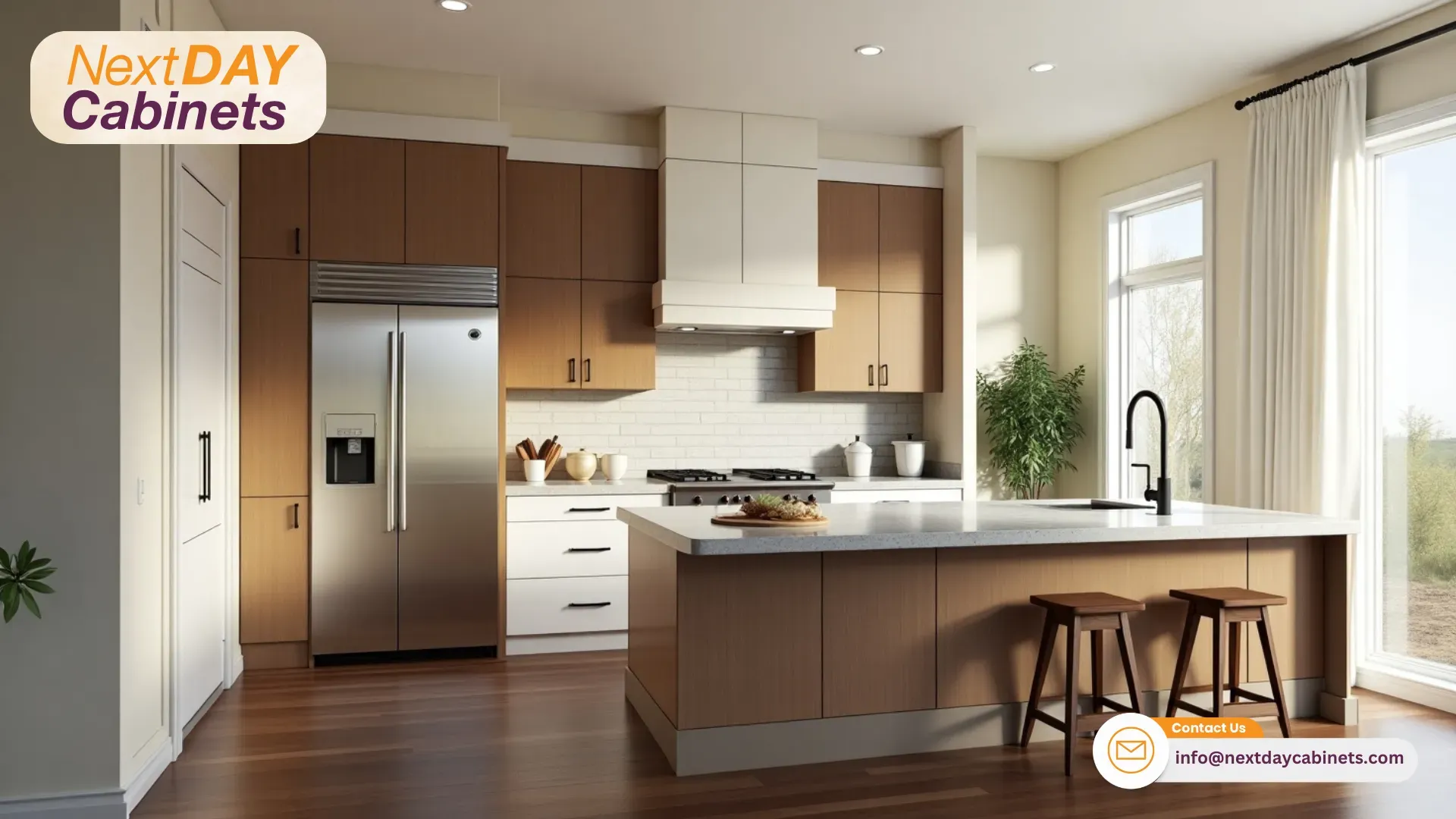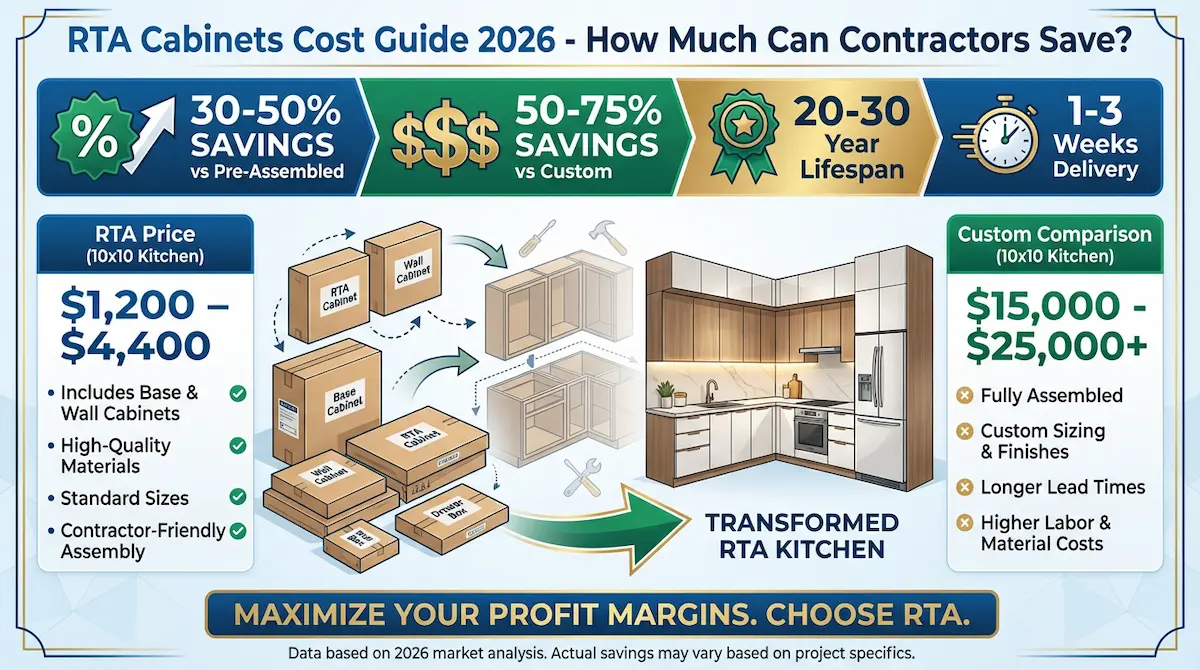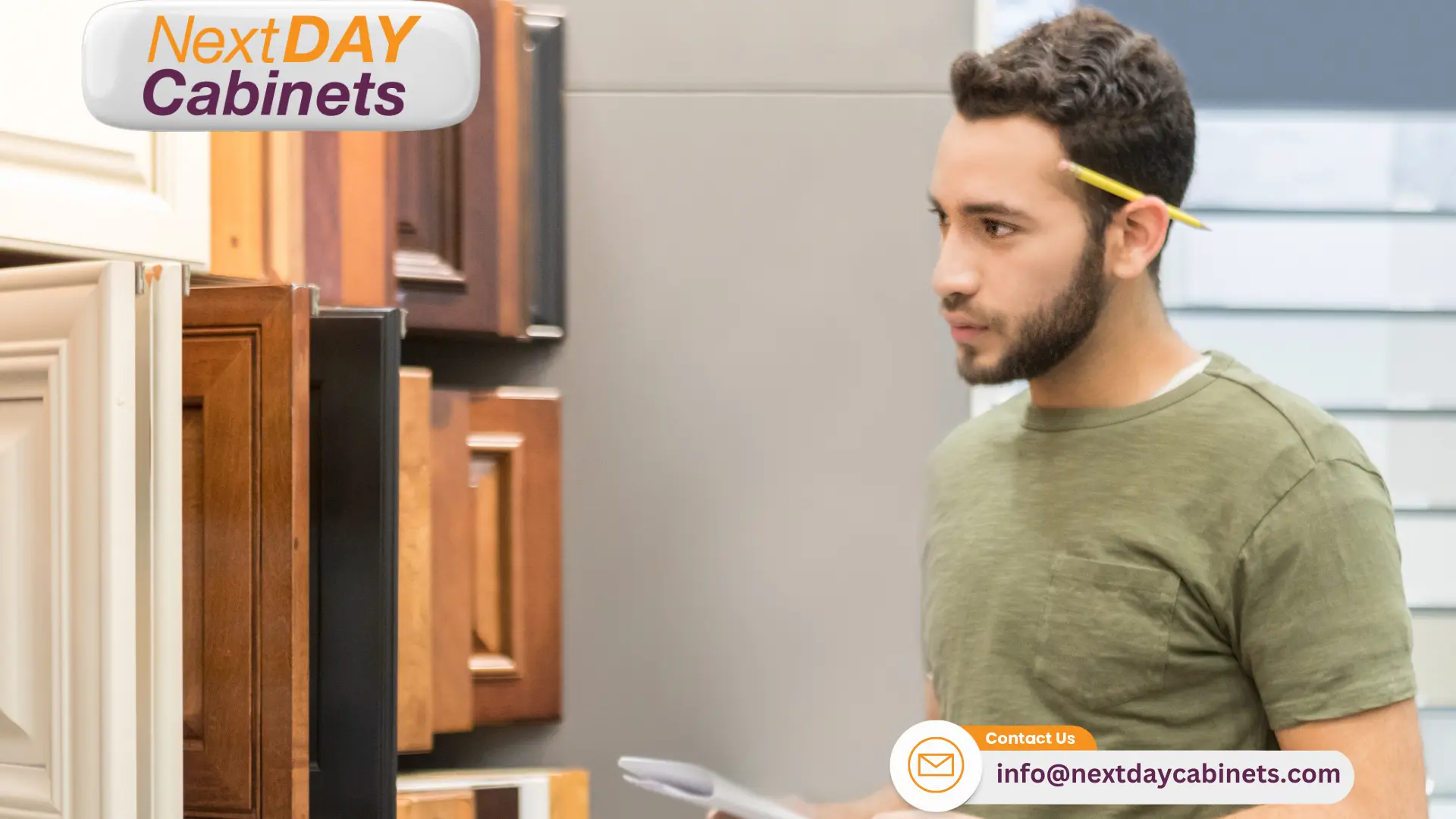
Kitchen Cabinets Buying Guide for Contractors: Top Tips
Are you a contractor looking to streamline your kitchen cabinet selection process? This guide offers essential tips for choosing the right cabinets for your clients’ projects. We’ll cover understanding client preferences, selecting materials, exploring design options, and finding reliable suppliers like NextDAY Cabinets in Richmond, VA.
You’ll learn to manage costs effectively and ensure accurate measurements for successful installations. Following these top tips, you can deliver high-quality kitchen renovations that meet your client’s needs and boost your business.

Key Takeaways for Kitchen Cabinets Buying Guide for Contractors: Top Tips
- Understand Client Needs: Assessing clients’ kitchen layouts, styles, materials, and storage requirements is essential for selecting appropriate cabinets.
- Balance Cost and Quality: Contractors should balance cost-effective materials and quality to ensure client satisfaction and profitability.
- Supplier Relationships: Building solid relationships with suppliers can lead to better pricing, service, and access to exclusive products.
- Accurate Measurements: Precise measurements are crucial for successful cabinet installations, minimizing errors, and ensuring a proper fit.
- Storage Solutions: Identifying clients’ storage needs allows contractors to recommend specialized cabinetry options that enhance functionality.
- Budget Alignment: Aligning cabinet choices with clients’ budgets is vital for project success, considering stock, semi-custom, or custom options.
- Material Selection: Evaluating various cabinet materials—wood vs. composites—helps contractors recommend the best options based on durability and maintenance.
- Design Options: To meet client preferences, contractors should explore both traditional and contemporary designs, door styles, and finishes.
- Functional Hardware: Prioritizing hardware that enhances functionality (e.g., soft-close hinges) improves user experience and cabinet longevity.
- Customization Opportunities: Leveraging online ordering systems allows contractors to customize cabinets according to specific client requests while managing costs.
- Supplier Evaluation: Researching trusted suppliers involves assessing pricing, warranty offerings, delivery schedules, and overall reputation in the industry.
- Installation Best Practices: Following best practices for measurements and installation techniques ensures high-quality results and minimizes potential challenges.
Understanding Your Clients’ Needs and Preferences
Understanding client’s needs is crucial for contractors when selecting kitchen cabinets. This process involves assessing the kitchen layout, identifying preferred styles and materials like particleboard or laminate cabinets, determining storage requirements, and aligning choices with budgets. By addressing these factors, contractors can guide homeowners toward optimal cabinet solutions, including options such as MDF or glass-front cabinets that meet functional and aesthetic preferences.
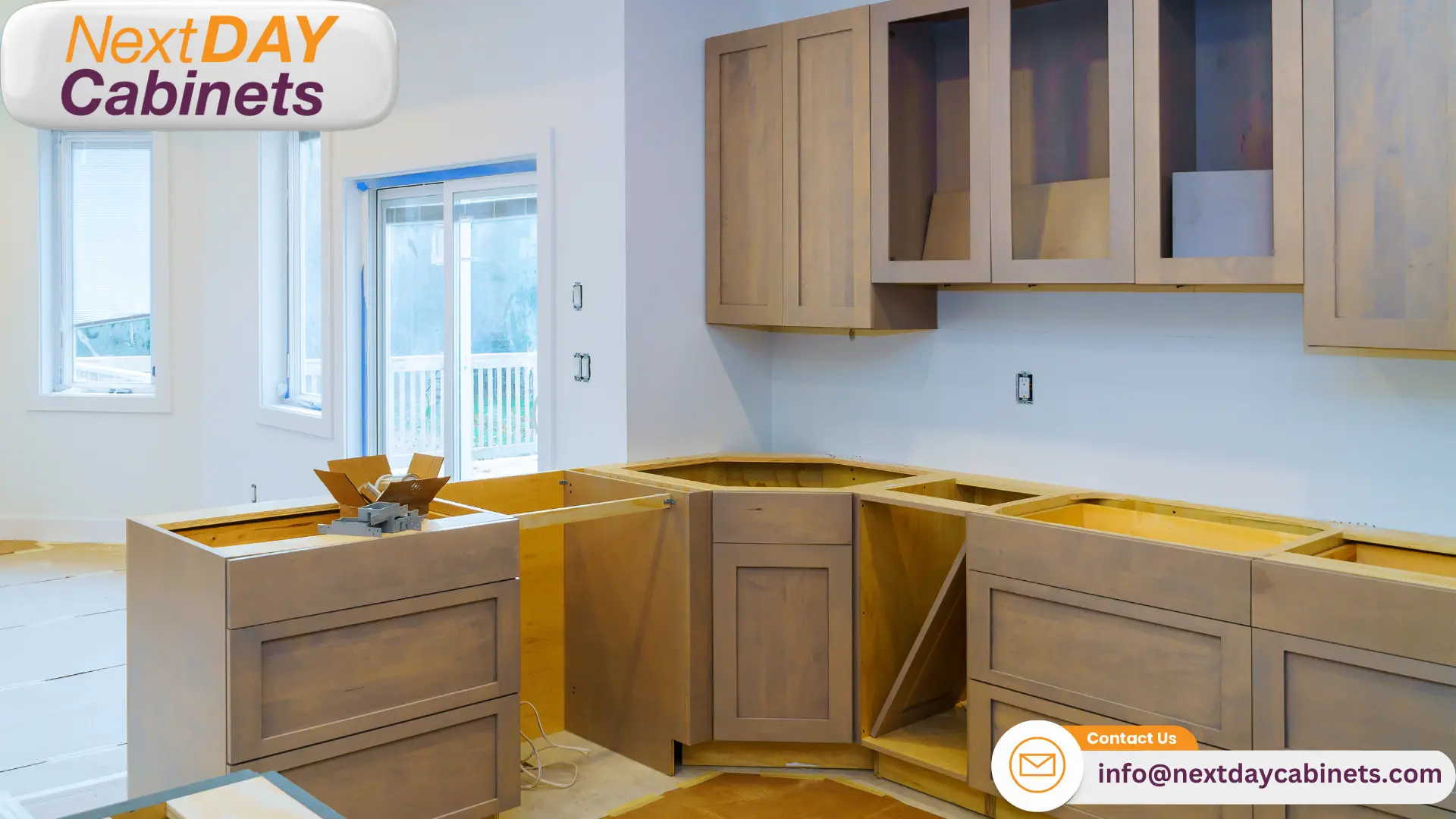
Assess the Kitchen Layout and Space Requirements
When selecting kitchen cabinets, assessing the kitchen layout and space requirements is a critical first step for contractors. The existing floor plan dictates the available space for cabinetry, influencing decisions on cabinet sizes, configurations, and storage solutions. Contractors must carefully measure the kitchen, considering wall lengths, window and door placements, and appliance locations to determine the optimal cabinet layout.
The choice of cabinet materials, such as wood, MDF, or laminate, can impact the overall space utilization in the kitchen. For instance, thinner laminate cabinets may provide more interior storage than thicker wood options. Contractors should also consider vertical space utilization, recommending tall cabinets or ceiling-height units when appropriate to maximize storage capacity and create a cohesive look in the kitchen.
Identify Preferred Cabinet Styles and Materials
Contractors must work closely with clients to identify preferred cabinet styles and materials that align with their vision and functional needs. This process involves discussing various cabinetry options, including traditional wood, modern particle board, and versatile MDF materials. Clients may prefer specific drawer styles, paint finishes, or countertop pairings that complement their desired aesthetic.
To effectively guide clients, contractors should present a range of cabinet samples and provide insights into the pros and cons of different materials. This approach helps clients make informed decisions about durability, maintenance, and cost-effectiveness. Contractors can also suggest how certain cabinet styles and materials can enhance the kitchen design<span style=”font-weight: 400;”>, creating a cohesive look that balances functionality with visual appeal.
- Assess client preferences for cabinet styles (traditional, modern, transitional)
- Discuss material options (wood, particle board, MDF)
- Consider drawer styles and hardware choices
- Evaluate paint finishes and color schemes
- Recommend complementary countertop materials.
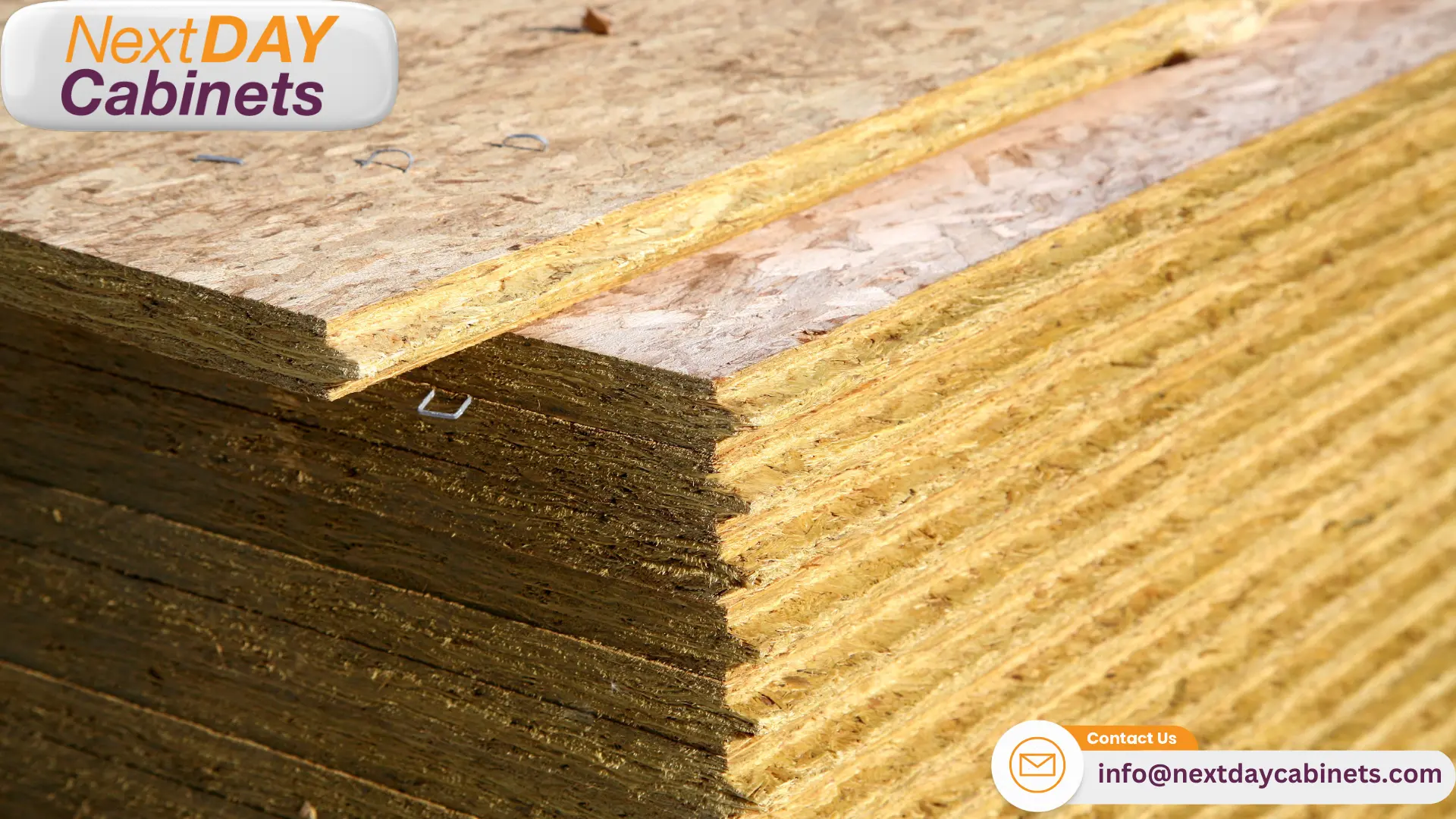
Determine Storage and Functionality Requirements
Contractors must determine storage and functionality requirements when selecting kitchen cabinets. Clients’ cooking habits, appliance preferences, and organizational needs significantly influence cabinet design and layout. To maximize efficiency in the kitchen renovation process, contractors should assess the need for specialized storage solutions, such as pull-out pantries, spice racks, or built-in appliance garages.
Choosing cabinet materials like plywood or particleboard can impact storage capacity and durability. To ensure optimal functionality, contractors must consider factors like drawer capacity, adjustable shelving options, and cabinet depth. By aligning these requirements with the client’s budget and preferred brands, contractors can recommend cabinet designs that offer the best balance of price, quality, and practicality:
| Storage Need | Cabinet Solution | Benefits |
|---|---|---|
| Pantry Items | Pull-out Shelves | Easy access, maximizes space |
| Pots and Pans | Deep Drawers | Organized storage reduces clutter |
| Small Appliances | Appliance Garage | Hides clutter, keeps counters clear |
| Spices | Door-mounted Racks | Easy access, saves cabinet space |
Align Cabinet Choices With Clients’ Budgets
Aligning cabinet choices with clients’ budgets is crucial for contractors to ensure customer satisfaction and project success. Contractors should assess the available budget early in the planning process, considering factors such as cabinet materials, construction quality, and design complexity. This evaluation helps determine whether stock, semi-custom, or custom cabinets are most appropriate for the space and budget constraints.
Contractors can optimize cabinet selections by balancing cost-effective options with client preferences for aesthetics and functionality. For instance, choosing in-stock cabinet sizes and limiting custom features can significantly reduce costs without compromising quality or appearance. Additionally, contractors can suggest alternative materials or finishes that achieve a similar look to higher-end options while staying within budget constraints:
- Evaluate budget constraints and client expectations.
- Consider stock, semi-custom, and custom cabinet options
- Balance material quality with cost-effectiveness
- Suggest alternative finishes or hardware to achieve the desired aesthetics
- Optimize cabinet layout to maximize space utilization within budget.
Selecting the Right Cabinet Materials
Selecting the right cabinet materials is crucial for contractors in kitchen renovations. This section compares wood types and composites, examines durability and maintenance requirements, explores sustainable options, and balances cost with quality. Contractors must consider factors like fiberboard durability and storage capacity to achieve optimal interior design results. Understanding these aspects ensures successful home improvement projects that meet client expectations and advertisement claims.
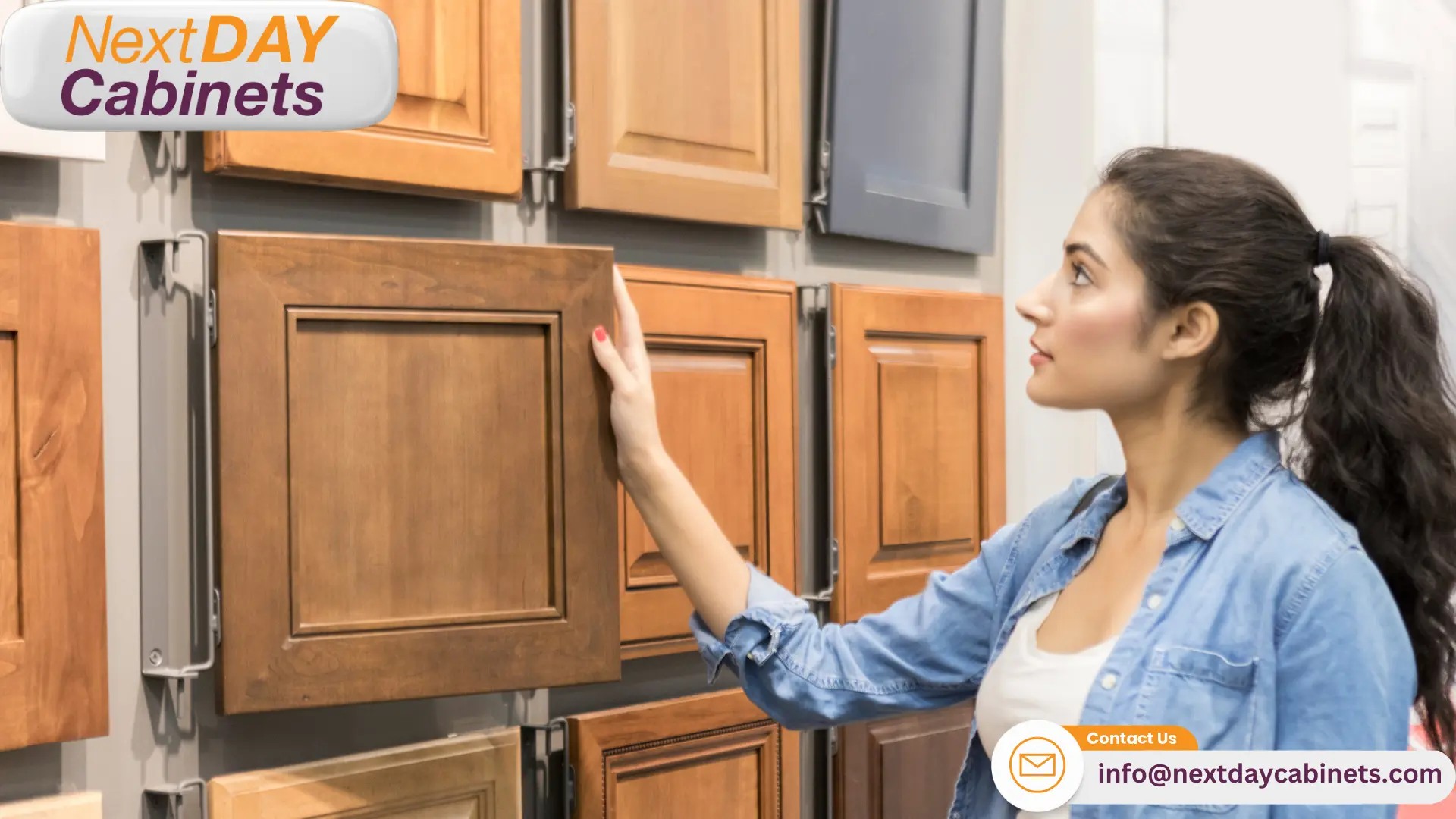
Compare Various Wood Types and Composites
Contractors must carefully evaluate various wood types and composites when selecting kitchen cabinets for renovation projects. Solid wood options like oak, maple, and cherry offer durability and a timeless appeal, making them suitable for creating a dream kitchen. Alternatively, engineered wood products such as medium-density fiberboard (MDF) and particleboard provide cost-effective solutions for stock cabinets and pantry units.
Contractors should consider moisture resistance, weight, and aesthetic versatility when comparing materials. Wood veneers applied to engineered cores can offer the best of both worlds, combining the natural beauty of wood with the stability of composites. This approach allows for a broader range of design possibilities while maintaining structural integrity in various kitchen environments:
| Material | Pros | Cons | Best Use |
|---|---|---|---|
| Solid Wood | Durable, timeless appeal | Expensive, susceptible to warping | High-end kitchens, custom designs |
| MDF | Cost-effective, smooth surface | Less durable than solid wood | Painted cabinets, budget-friendly options |
| Particleboard | Affordable, lightweight | Prone to moisture damage | Stock cabinets, pantry units |
| Wood Veneer | Natural look, stable core | Can peel over time | Mid-range kitchens, diverse styles |
Consider Durability and Maintenance Needs
Contractors must carefully consider durability and maintenance needs when selecting cabinet materials for kitchen renovations. Hardwood cabinets, such as those made from oak or maple, offer exceptional durability and longevity, withstanding daily use and potential impacts from cookware. However, they require regular maintenance, including periodic refinishing, to maintain their appearance and protect against moisture damage.
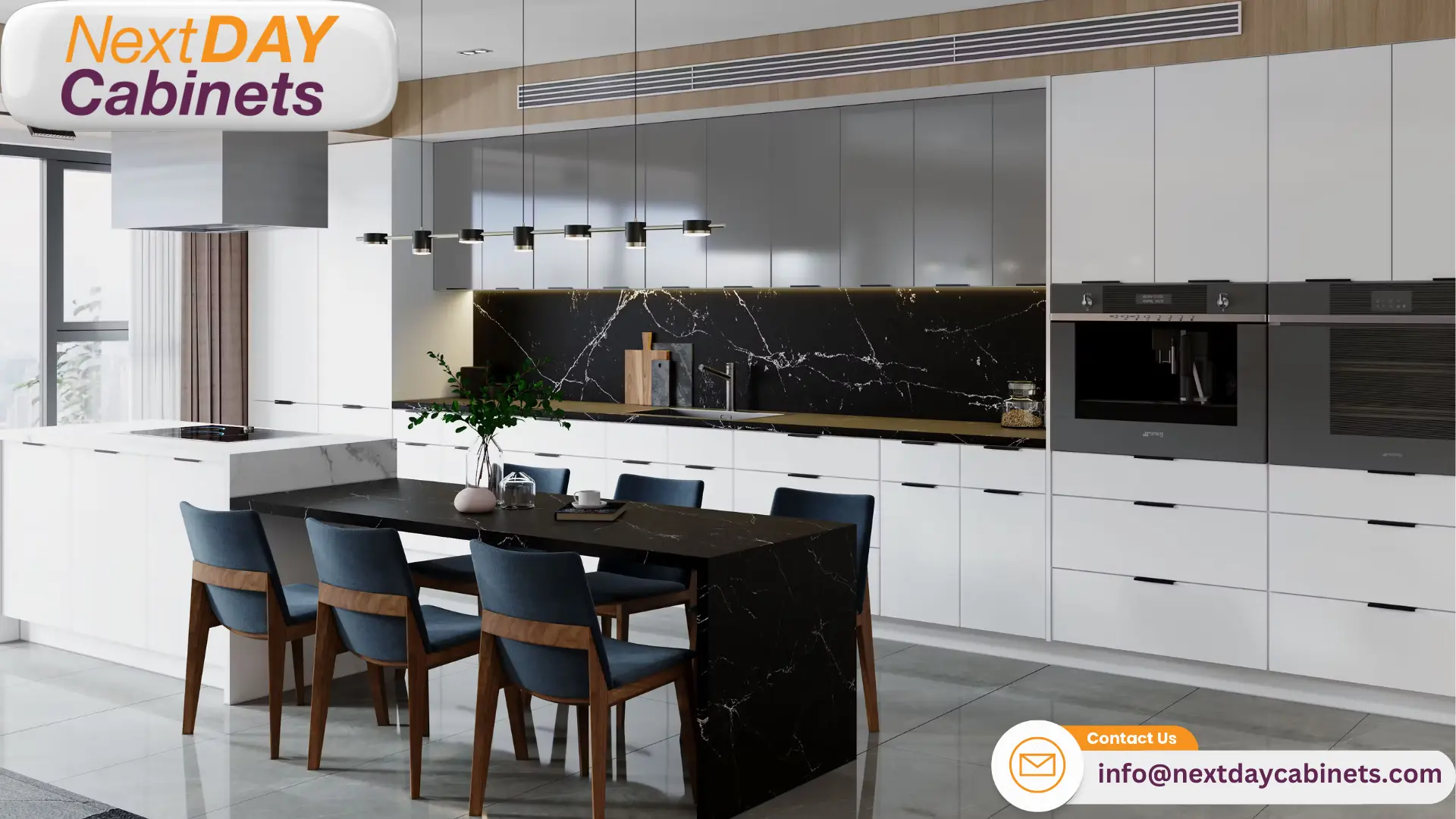
For areas prone to moisture, such as those near the sink or dishwasher, contractors should recommend materials like stainless steel or high-quality plywood with a moisture-resistant finish. These options resist warping and swelling, ensuring longevity in challenging kitchen environments. Additionally, features like lazy susan units in corner cabinets can enhance accessibility while reducing wear on cabinet surfaces:
| Cabinet Material | Durability | Maintenance Needs | Best Applications |
|---|---|---|---|
| Hardwood | High | Regular refinishing | Main cabinetry, visible areas |
| Stainless Steel | Very High | Minimal cleaning | Near sinks, high-moisture areas |
| Plywood | Medium | Periodic sealing | Budget-friendly options, interior structures |
| Laminate | Medium | Easy cleaning, avoid abrasives | Low-cost renovations, rental properties |
Opt for Sustainable and Eco-Friendly Options
Contractors should prioritize sustainable and eco-friendly cabinet options to meet growing environmental concerns. Materials like reclaimed wood, bamboo, and wood veneers from certified sustainable forests offer durability while minimizing ecological impact. These choices appeal to environmentally conscious clients and provide unique aesthetic qualities, such as the character found in reclaimed wood or the sleek appearance of bamboo.
For metal components like hinges and drawer slides, contractors can recommend options made from recycled materials or those designed for longevity to reduce waste. Glass cabinet doors, when sourced from recycled glass, offer another eco-friendly alternative that adds visual interest while resisting water damage. By incorporating these sustainable materials, contractors can create environmentally responsible and stylish kitchens.
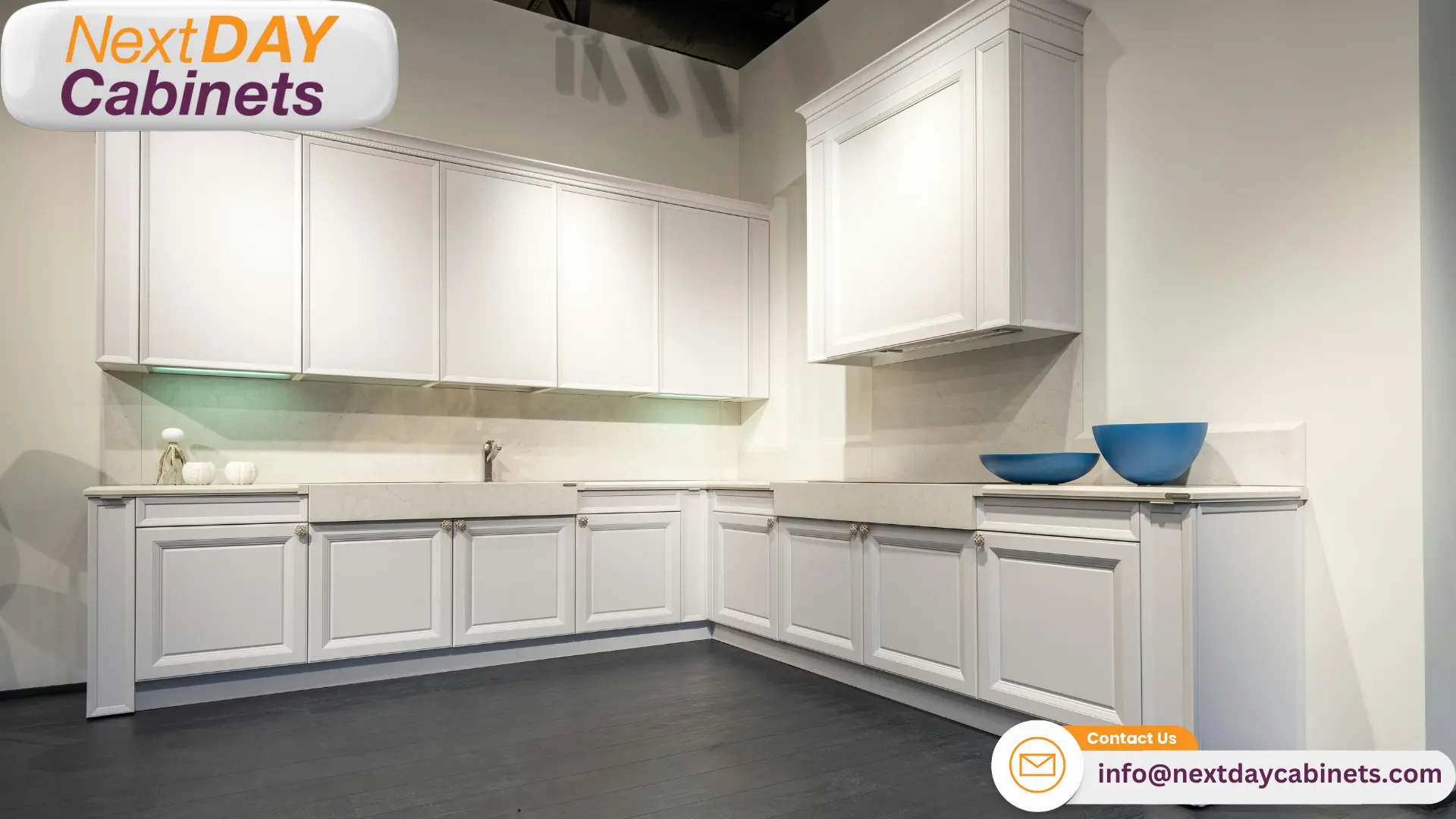
Balance Cost With Material Quality
Contractors must carefully balance cost with material quality when selecting kitchen cabinets, ensuring the best value for their client’s investments. In New Jersey‘s competitive retail market, opting for mid-range materials like plywood or MDF can offer a good compromise between durability and affordability for furniture-grade cabinetry. These materials provide sturdy construction suitable for cooking environments while keeping costs manageable for homeowners.
To maximize value, contractors should consider factors such as warranty coverage, hardware quality, and construction techniques when evaluating cabinet options. Selecting cabinets with solid wood fronts and engineered wood boxes can provide a high-end look and durability in critical areas while maintaining a reasonable price point. This approach allows contractors to deliver quality kitchen renovations that meet both budget constraints and performance expectations.
Exploring Cabinet Design and Style Options
Exploring cabinet design and style options is crucial for contractors selecting kitchen cabinets. This section covers traditional and contemporary designs, door styles and finishes, functional hardware choices, and customization options. Contractors must consider factors like thermofoil durability, steel hardware quality, and warranty terms to ensure optimal selections for clients’ kitchens.
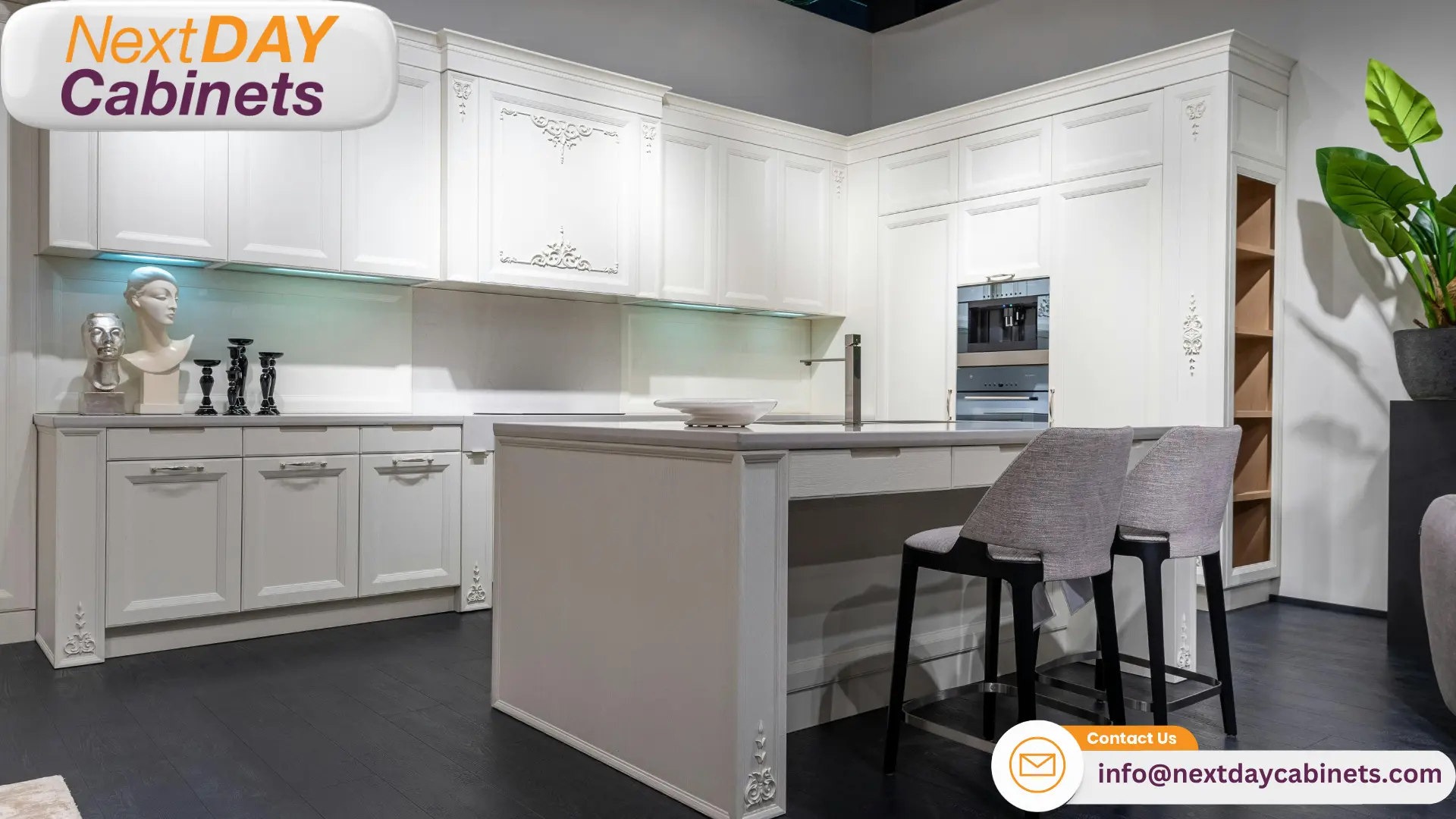
Choose Between Traditional and Contemporary Designs
Contractors must guide customers in choosing between traditional and contemporary cabinet designs, considering the overall kitchen aesthetic and the homeowner’s taste. Traditional designs often feature ornate details, raised panel doors, and warm finishes that create a timeless, classic look. These styles complement older homes or kitchens, aiming for a cozy, familiar atmosphere while providing ample storage solutions for various kitchen layouts.
Conversely, contemporary cabinet designs emphasize clean lines, minimalist hardware, and sleek surfaces that appeal to modern sensibilities. These cabinets often incorporate innovative storage solutions and may feature frameless construction or full-overlay doors for a seamless appearance. Contractors should assess the existing floor plan and discuss customer service preferences to determine which style best suits the client’s needs and enhances the kitchen design<span style=”font-weight: 400;”>.
Decide on Door Styles and Finishing Touches
Contractors must carefully consider door styles and finishing touches when selecting kitchen cabinets, as these elements significantly impact the overall aesthetic and cost of the project. Shaker-style doors, with their simple frame-and-panel design, offer versatility and timeless appeal, making them suitable for various kitchen layouts, including those with ceiling-height cabinets or engineered wood flooring. Flat-panel doors provide a sleek appearance that complements contemporary cooktops and appliances for a more modern look.
Finishing touches, such as hardware and paint colors, are crucial in tying the cabinet design to the kitchen‘s overall theme. To ensure informed decisions, contractors should provide clients with detailed information on finish options, including durability and maintenance requirements. For instance, a high-gloss finish on engineered wood cabinets can create a striking visual impact but may require more frequent cleaning than matte finishes.
Incorporate Hardware That Enhances Functionality
Contractors should prioritize hardware that enhances functionality when selecting kitchen cabinets, considering options like soft-close hinges and full-extension drawer slides. These features improve the user experience and protect cabinet finishes, including lacquer and oak surfaces, from wear and tear. When choosing hardware, contractors should also consider durability and ease of use, especially for clients who plan to buy cabinets online.
To prevent mold growth and ensure longevity, contractors should recommend moisture-resistant hardware for areas prone to humidity. This is particularly important for oak cabinets susceptible to moisture damage. By incorporating high-quality hardware, contractors can enhance the overall functionality and value of the kitchen cabinets, whether purchased in-store or through online platforms:
| Hardware Type | Functionality | Best for Cabinet Material |
|---|---|---|
| Soft-close hinges | Prevents slamming, reduces wear | Lacquer, Oak |
| Full-extension slides | Maximizes drawer access | All materials |
| Push-to-open mechanisms | Enables handleless designs | Modern finishes |
| Moisture-resistant pulls | Prevents corrosion in humid areas | Oak, near sinks |
Customize Cabinets to Meet Specific Client Requests
Contractors can effectively customize cabinets to meet specific client requests by leveraging online ordering systems and wholesale cabinet options. When clients wish to buy cabinet doors or kitchen cabinet doors separately, contractors can explore platforms that offer a wide range of styles and materials, ensuring a perfect match for the existing kitchen design. This approach allows for greater flexibility in mixing and matching components while potentially reducing costs compared to total cabinet replacements.
To address budget concerns, contractors should familiarize themselves with options like IKEA kitchen cabinets price lists and other affordable alternatives. By combining cost-effective base units with custom doors or finishes, contractors can create unique, personalized designs that meet client specifications without exceeding budget constraints. This strategy allows for incorporating high-end elements in critical areas while maintaining overall project affordability through wholesale cabinets and online ordering platforms.
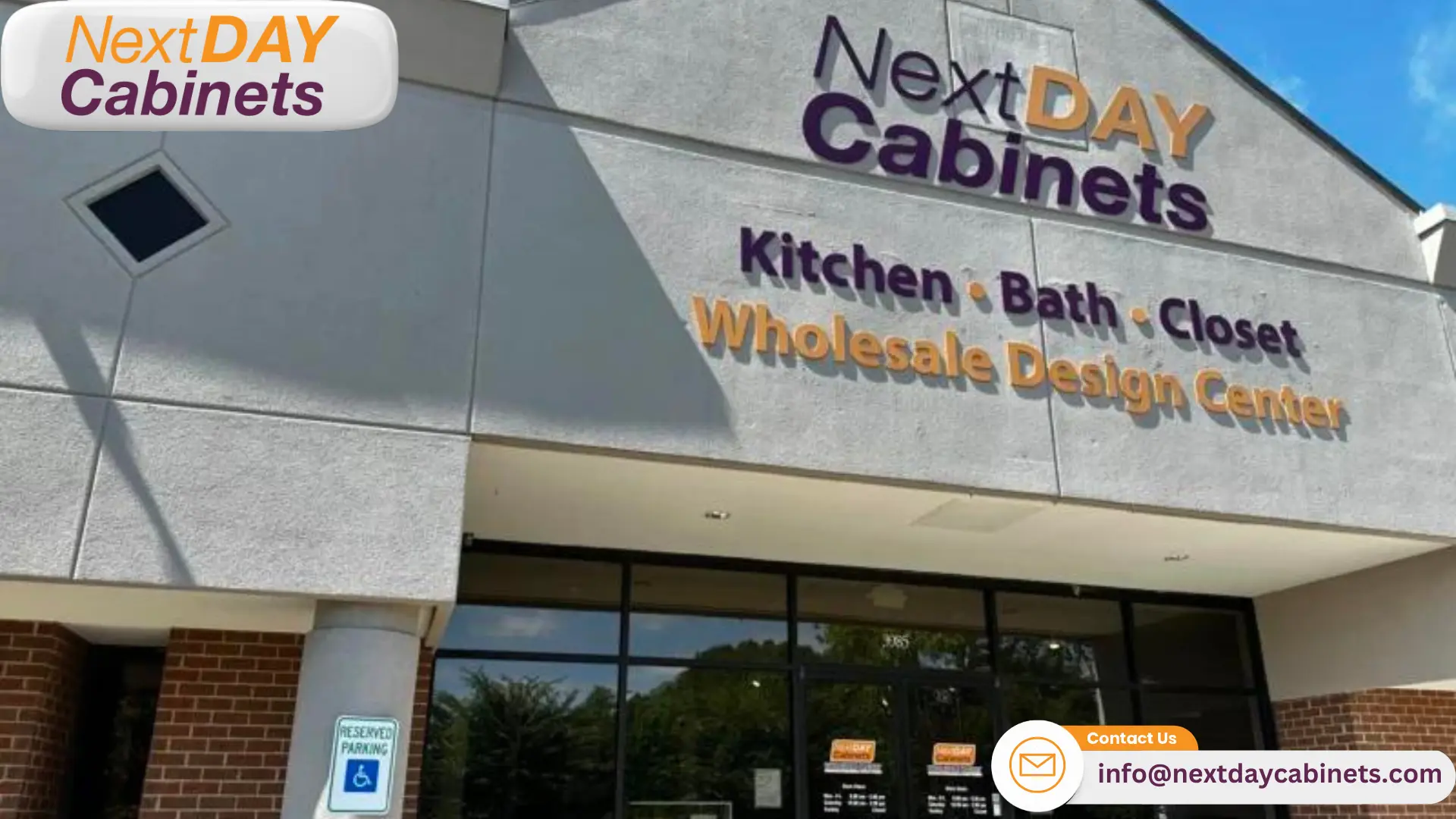
Finding Reliable Suppliers and Manufacturers
Finding reliable suppliers and manufacturers is crucial for contractors looking to buy kitchen cabinets. This section explores how to research trusted providers, evaluate pricing and warranties, check delivery schedules, and build strong supplier relationships. Contractors will learn strategies to shop for kitchen cabinets efficiently, buy cabinet doors online, and order kitchen cabinets from reputable sources, ensuring quality and timely project completion.
Research Trusted Cabinet Providers
Contractors seeking reliable cabinet providers should conduct thorough research to identify reputable suppliers and manufacturers. This process involves examining online reviews, industry ratings, and testimonials from other professionals. Contractors can also explore “Become a Dealer” options with established brands, which often provide access to exclusive product lines and competitive pricing.
To streamline the selection process, contractors should review the FAQ sections of potential suppliers’ websites, focusing on warranty coverage, customization options, and delivery times. Some suppliers may offer opportunities to “buy used kitchen cabinets,” which can be a cost-effective solution for budget-conscious projects. By thoroughly vetting potential providers, contractors can ensure they partner with reliable suppliers who meet their quality and service expectations.
Evaluate Supplier Pricing and Warranty Offerings
When selecting kitchen cabinet providers, contractors should meticulously evaluate supplier pricing and warranty offerings. They must compare quotes from multiple suppliers, considering bulk discounts, shipping costs, and additional customization fees. Contractors should also assess the comprehensiveness of warranty coverage, including duration, exclusions, and claim processes, to ensure long-term value for their clients.
To make informed decisions, contractors can create a comparative analysis of different suppliers’ offerings. This analysis should include the upfront costs and potential long-term expenses related to maintenance and replacements. By weighing these factors against the quality and durability of the cabinets, contractors can identify the most cost-effective options that meet their client’s needs:
| Supplier | Price Range | Warranty Duration | Customization Fees | Bulk Discount |
|---|---|---|---|---|
| Supplier A | $2,000 – $5,000 | 5 years | 10% of base price | 15% for orders over $10,000 |
| Supplier B | $1,800 – $4,500 | 3 years | Flat fee of $200 | 10% for orders over $8,000 |
| Supplier C | $2,200 – $5,500 | Lifetime limited | No fee | 20% for orders over $15,000 |
Check Delivery Schedules and Lead Times
Contractors must carefully check delivery schedules and lead times when selecting cabinet suppliers. Accurate timelines are crucial for project planning and client satisfaction. To ensure smooth project execution, contractors should request detailed delivery information, including estimated arrival dates and any potential delays.
To optimize project timelines, contractors can create a comprehensive delivery schedule with buffer periods for unexpected delays. This approach facilitates better coordination with other trades and helps manage client expectations. Contractors should also inquire about expedited shipping options for time-sensitive projects:
| Supplier | Standard Lead Time | Expedited Option | Minimum Order for Free Shipping |
|---|---|---|---|
| Supplier A | 4-6 weeks | 2-3 weeks (+15% fee) | $5,000 |
| Supplier B | 3-5 weeks | 1-2 weeks (+20% fee) | $3,500 |
| Supplier C | 5-7 weeks | 3-4 weeks (+10% fee) | $7,500 |
Establish Strong Relationships With Suppliers
Contractors should prioritize establishing solid relationships with cabinet suppliers to ensure consistent quality, competitive pricing, and reliable service. By maintaining open communication channels and demonstrating loyalty, contractors can often negotiate better terms, access exclusive product lines, and receive priority project support. This approach helps streamline the cabinet selection and procurement process, benefiting the contractor and their clients.
To foster these relationships, contractors should consider participating in supplier-sponsored training programs, attending industry events, and providing regular feedback on products and services. By demonstrating a commitment to the supplier’s success, contractors can position themselves as valuable partners, potentially unlocking benefits such as extended payment terms, expedited shipping, or custom design support. These advantages can significantly enhance a contractor’s ability to deliver high-quality kitchen renovations efficiently and cost-effectively:
| Relationship-Building Strategy | Potential Benefits | Implementation Timeline |
|---|---|---|
| Attend supplier training programs | Access to new product knowledge, installation techniques | Quarterly |
| Provide regular product feedback | Influence on future product developments, early access to innovations | Monthly |
| Participate in industry events | Networking opportunities, exposure to market trends | Bi-annually |
| Maintain consistent order volumes | Improved pricing, priority shipping | Ongoing |
Ensuring Accurate Measurements and Installation
Accurate measurements and installation are crucial for successful kitchen cabinet projects. Contractors must measure spaces precisely, prepare for potential challenges, utilize proper tools, and follow best practices for efficient installation. These steps minimize errors, reduce delays, and ensure client satisfaction throughout the renovation process.
Measure Spaces Precisely to Avoid Errors
Contractors must measure kitchen spaces precisely to avoid costly cabinet selection and installation errors. Accurate measurements ensure proper fit, functionality, and aesthetics of the cabinetry. To create a detailed floor plan, contractors should use laser measuring tools and double-check all dimensions, including wall lengths, ceiling heights, and distances between fixtures.
Special attention must be given to obstacles such as windows, doors, and electrical outlets that may impact cabinet placement. Contractors should also account for appliance dimensions and clearances to ensure seamless integration with the cabinetry. By taking meticulous measurements, contractors can minimize the risk of ordering incorrect sizes or encountering installation issues, ultimately saving time and resources.
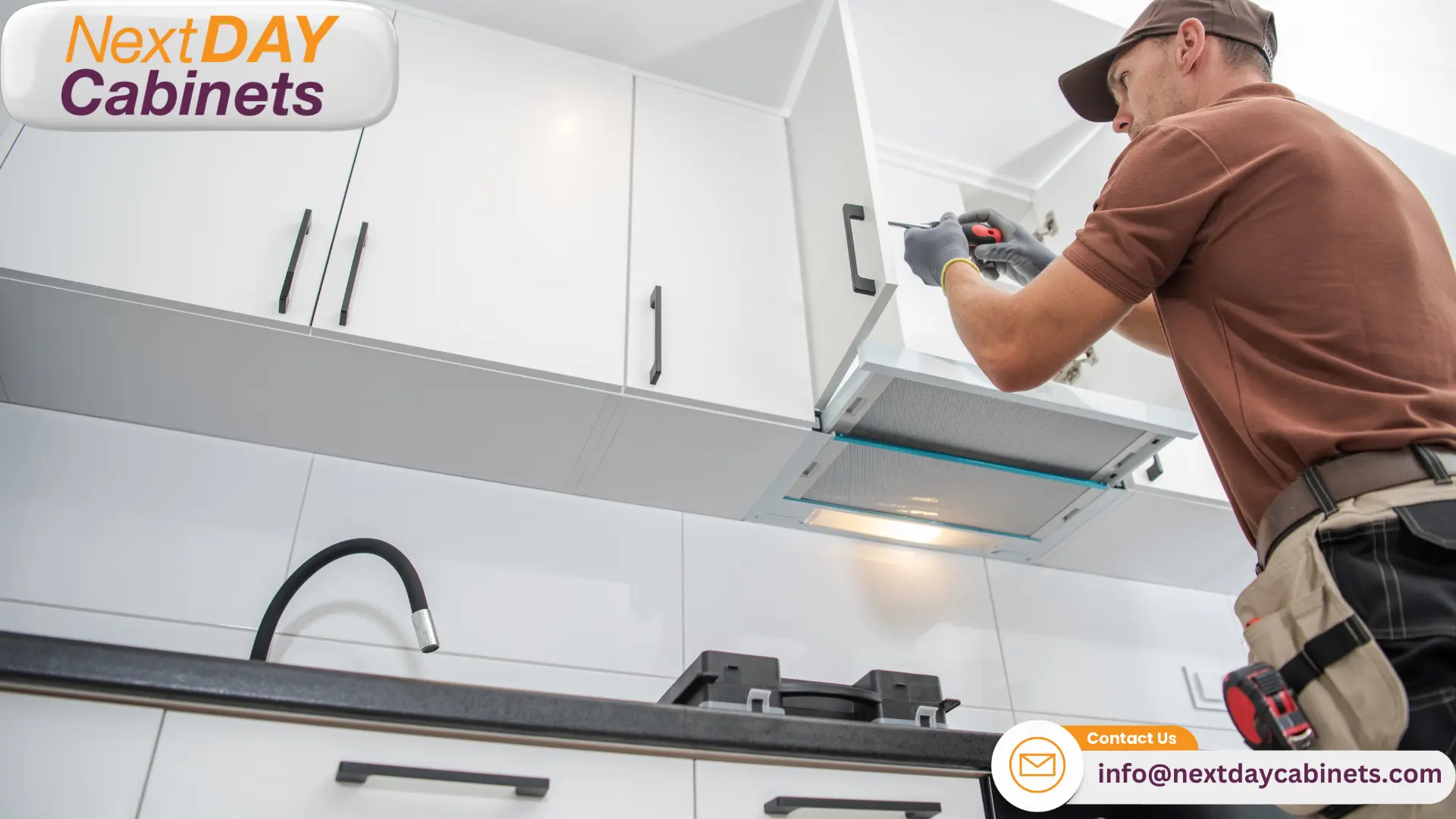
Prepare for Potential Installation Challenges
When preparing for kitchen cabinet projects, contractors must anticipate potential installation challenges. Uneven walls, out-of-square corners, and hidden obstacles like pipes or electrical wiring can complicate installation. To mitigate these issues, contractors should conduct thorough site assessments and use tools like stud finders and moisture meters to identify potential problems before installation begins.
Preparing for challenges also involves having contingency plans and appropriate materials on hand. Contractors should stock shims, filler strips, and scribe molding to address gaps and irregularities during installation. Additionally, they should familiarize themselves with the specific installation requirements of the chosen cabinet brand to ensure compliance with warranty terms. Here’s a table outlining common installation challenges and their solutions:
| Challenge | Solution | Required Materials |
|---|---|---|
| Uneven Walls | Use shims to level cabinets | Wooden shims, level |
| Out-of-Square Corners | Apply scribe molding | Scribe molding, coping saw |
| Hidden Pipes | Modify cabinet backs | Jigsaw, wood filler |
| Electrical Wiring | Create access holes | Hole saw, grommet |
Utilize Proper Tools and Techniques
Contractors must utilize proper tools and techniques to ensure accurate measurements and installation of kitchen cabinets. Essential tools include laser levels, stud finders, and high-quality measuring tapes to achieve precise dimensions and alignment. Contractors should also invest in specialized cabinet installation tools such as clamps, jigs, and cabinet screws to streamline the installation process and ensure secure attachment to walls and floors.
Proper cabinet installation techniques involve careful planning and sequencing of tasks. To prevent damage to lower units, contractors should begin by installing upper cabinets first, followed by base cabinets. They should also use shims to level cabinets and ensure proper door alignment. By employing these tools and techniques, contractors can achieve professional results and minimize the risk of costly errors or rework.
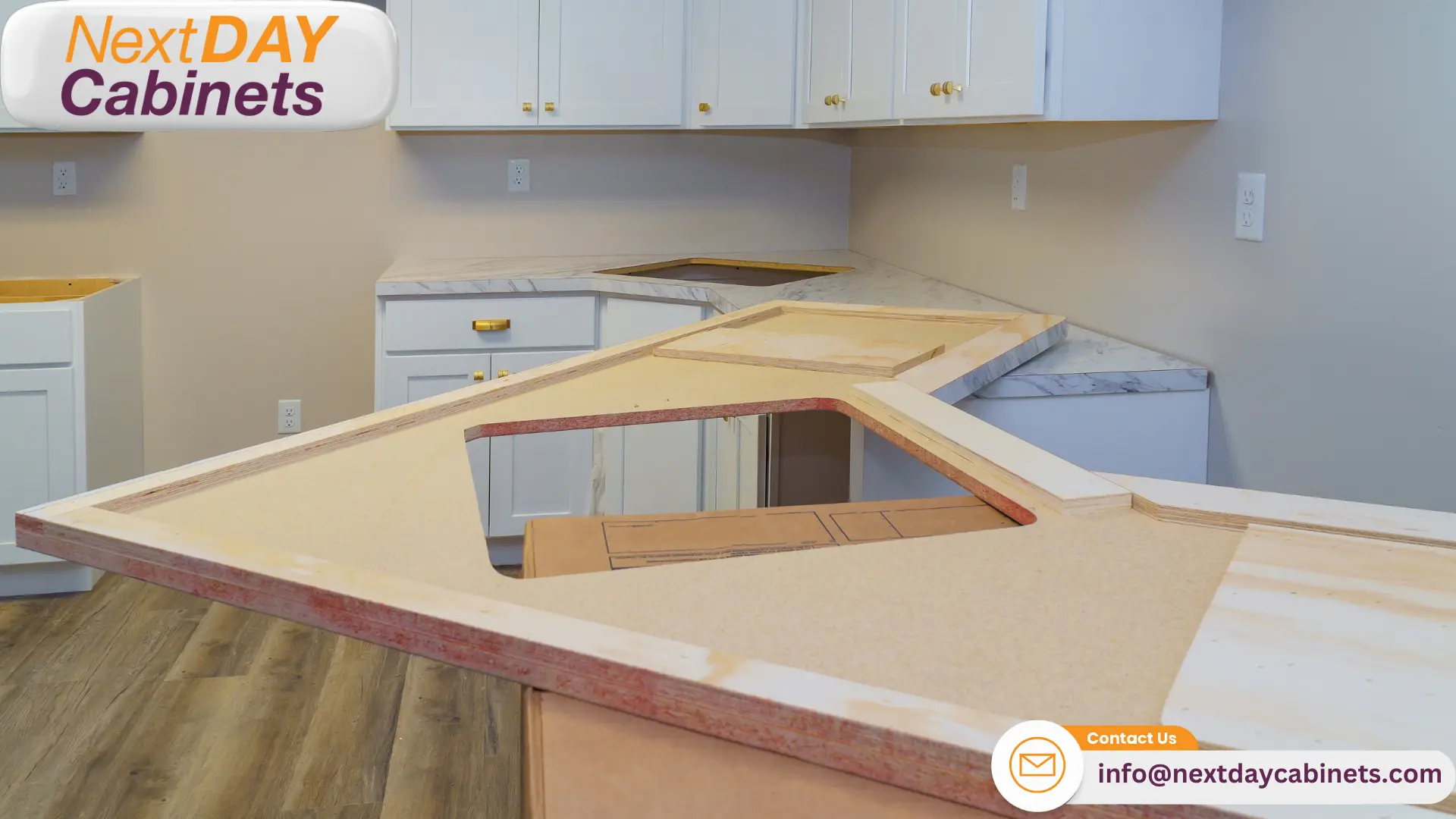
Follow Best Practices for Efficient Installation
Contractors should follow best practices for efficient cabinet installation to ensure quality results and client satisfaction. To minimize errors and rework, they should create a detailed installation plan, including cabinet layout and sequence. Proper preparation of the installation site, including leveling floors and marking stud locations, is crucial for a smooth process.
To maximize efficiency, contractors should organize tools and materials beforehand and use a systematic approach to installation. This includes starting with upper cabinets, using temporary support bars, and ensuring proper alignment before securing cabinets. Contractors should also pay close attention to hardware installation and door adjustments to achieve a polished final result. Here’s a table outlining key steps in the efficient installation process:
| Step | Description | Key Considerations |
|---|---|---|
| Site Preparation | Level floors, mark stud locations | Use laser level for accuracy |
| Upper Cabinet Installation | Install upper cabinets first | Use temporary support bars |
| Base Cabinet Installation | Install base cabinets after uppers | Ensure proper leveling |
| Hardware Installation | Add pulls, knobs, and hinges | Use templates for consistency |
Managing Project Costs and Maximizing Profits
Effective cost management is crucial for contractors in kitchen cabinet projects. This section explores creating detailed budget plans, implementing cost-saving measures without compromising quality, leveraging bulk-purchasing discounts, and offering competitive pricing. By mastering these strategies, contractors can maximize profits while delivering high-quality cabinet solutions to clients.
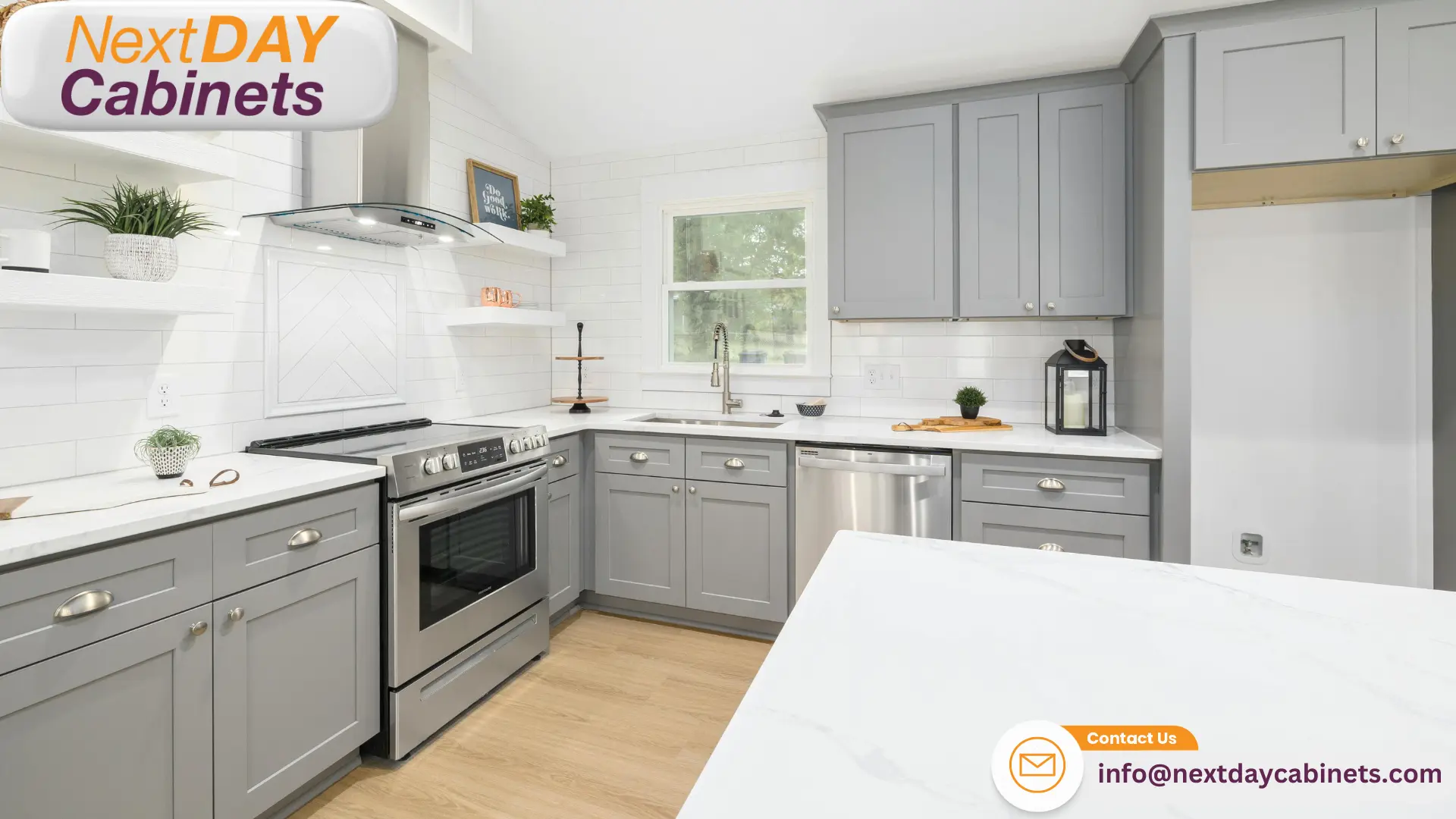
Create Detailed Budget Plans for Each Project
Contractors should create detailed budget plans for each kitchen cabinet project to ensure accurate cost estimation and profit maximization. These plans should include itemized costs for materials, labor, overhead expenses, and contingencies for unexpected issues. By breaking down costs into specific categories, contractors can identify areas for potential savings and maintain better control over project expenses.
To create effective budget plans, contractors should leverage historical data from previous projects and stay updated on current market prices for cabinets and related materials. They should also factor in client-specific requirements, such as custom features or high-end finishes, which may impact overall costs. Regular budget reviews throughout the project can help contractors stay on track and make timely adjustments to maintain profitability.
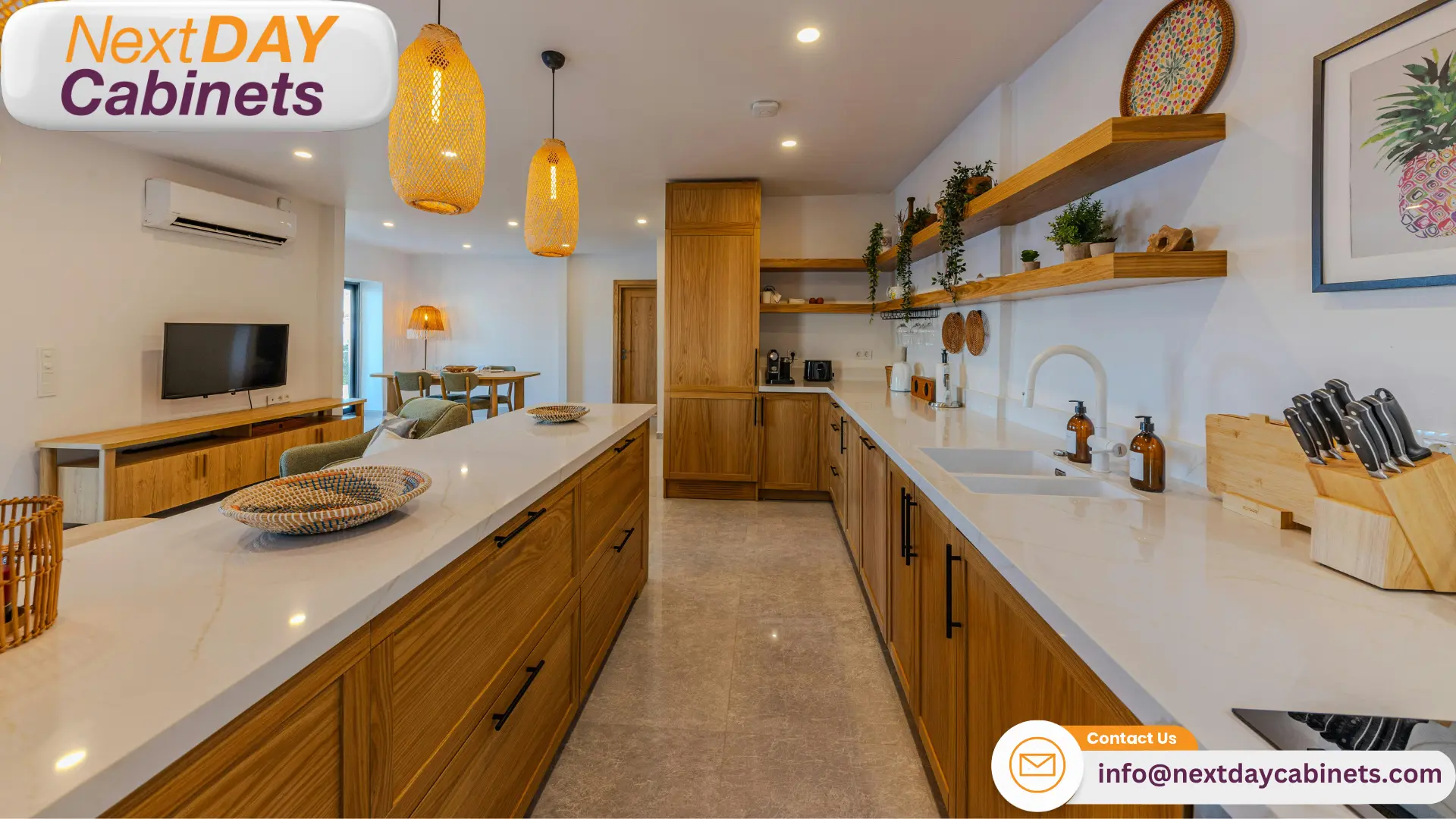
Implement Cost-Saving Measures Without Sacrificing Quality
Contractors can implement cost-saving measures without sacrificing quality by carefully selecting cabinet materials and finishes. They may opt for mid-range cabinet lines that offer durability and aesthetics at a lower price point than premium brands. Additionally, contractors can explore alternative materials, such as high-quality laminate or thermofoil finishes, which can mimic the look of more expensive wood options while providing excellent durability and easy maintenance.
Another effective cost-saving strategy is optimizing cabinet layouts to minimize waste and reduce the required custom pieces. Contractors can work with clients to prioritize features and allocate the budget towards high-impact areas, such as investing in quality hardware or incorporating strategic storage solutions. By focusing on value-driven choices and efficient design, contractors can deliver high-quality kitchen cabinets while maintaining project profitability.
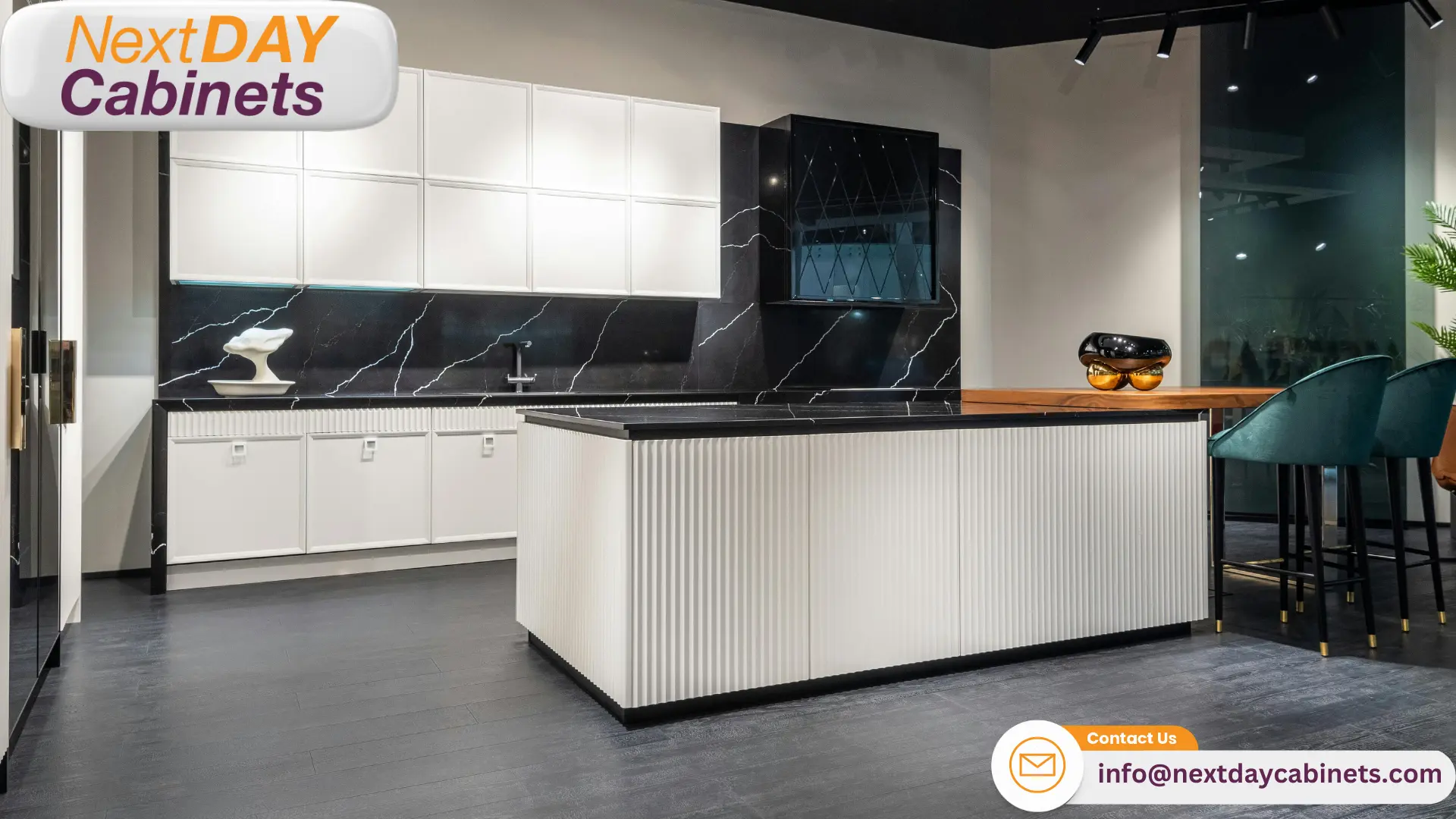
Take Advantage of Bulk Purchasing Discounts
Contractors can significantly reduce costs by offering bulk-purchasing discounts when ordering kitchen cabinets. They can negotiate better prices with suppliers by consolidating orders across multiple projects or partnering with other contractors. This approach lowers material costs and streamlines the procurement process, potentially reducing administrative overhead.
To maximize the benefits of bulk purchasing, contractors should carefully forecast their cabinet needs across upcoming projects. They can create a purchasing schedule that aligns with project timelines and storage capabilities, ensuring efficient inventory management. Additionally, contractors should compare bulk pricing options from various suppliers to secure the best deals:
- Analyze historical project data to estimate future cabinet requirements
- Negotiate volume-based discounts with multiple suppliers
- Consider forming purchasing cooperatives with other contractors
- Evaluate storage costs against potential savings from bulk orders
- Implement inventory tracking systems to optimize ordering cycles.
Offer Competitive Pricing to Attract More Clients
Contractors can implement a tiered pricing strategy to offer competitive pricing and attract more clients. This approach allows them to provide different cabinet options at various price points, catering to a wider range of budgets. By offering good-better-best options, contractors can appeal to cost-conscious clients while still providing opportunities for upselling to those with higher budgets.
To maintain profitability while offering competitive prices, contractors should optimize their supply chain and installation processes. They can negotiate better rates with suppliers, streamline their workflow, and invest in efficient tools and technologies. By reducing overhead costs and improving productivity, contractors can pass on savings to clients while maintaining healthy profit margins.
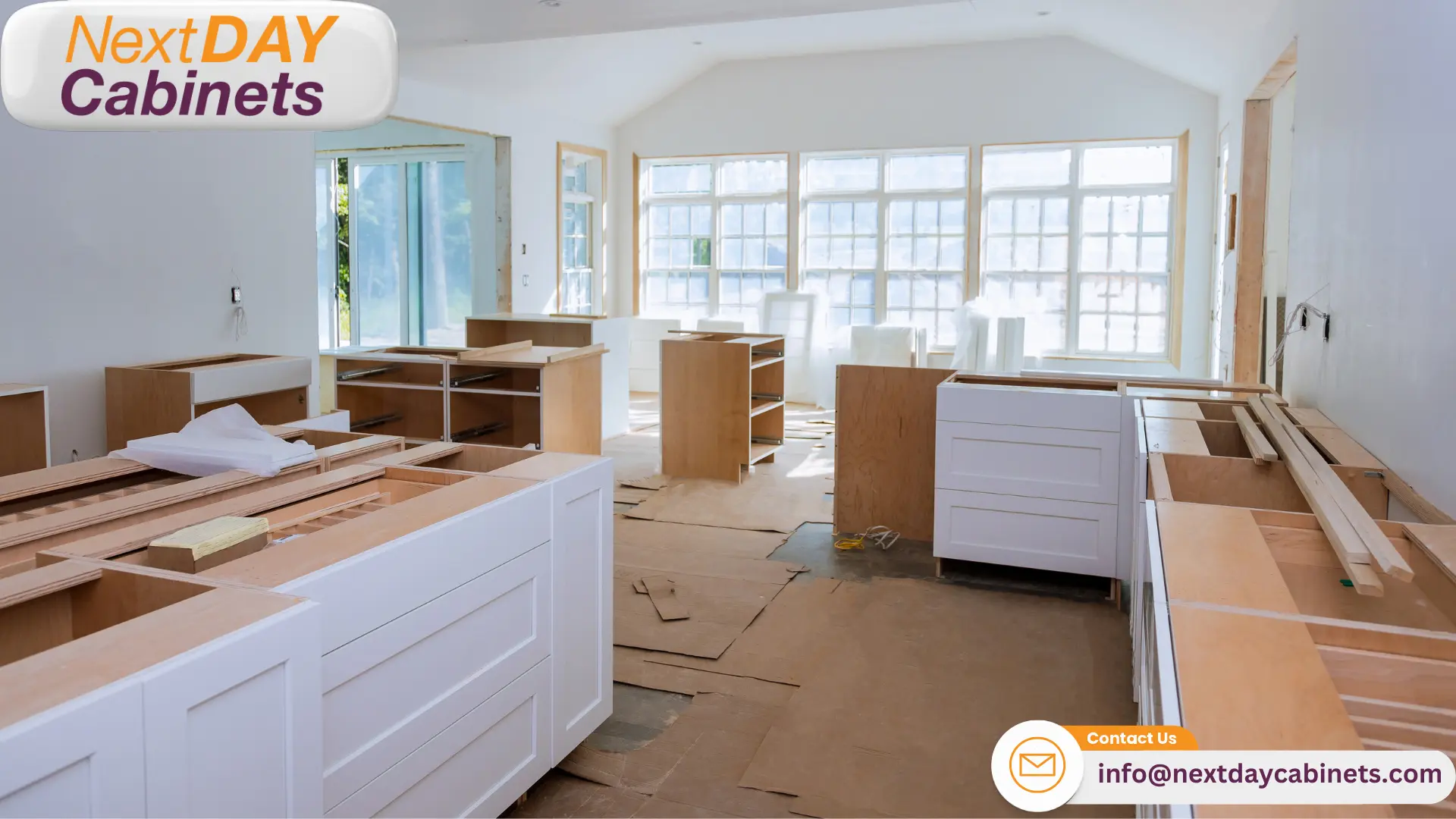
FAQs for Kitchen Cabinets Buying Guide for Contractors: Top Tips
How much do cabinets cost for a 12×12 kitchen?
The cost of kitchen cabinets for a 12×12 kitchen can vary widely depending on the materials, design options, and suppliers you choose. On average, you can expect to spend between $5,000 to $15,000 for semi-custom cabinets, with custom cabinets costing even more. Contractors who focus on kitchen cabinets buying for clients often recommend semi-custom options to balance cost and design flexibility. If you’re working with a tighter budget, stock cabinets can start as low as $3,000, but these may offer fewer storage solutions and customization options.
Key factors influencing the cost include cabinet styles, the type of wood or materials used, hardware, and whether eco-friendly or specialty finishes are used. Ensure your project planning includes proper measurements and cost management to stay within budget.
What time of year is best to buy kitchen cabinets?
The best time to invest in kitchen cabinets<span style=”font-weight: 400;”> is during annual sales, typically in late winter and early spring. Many contractors recommend waiting for holiday sales like Black Friday, Memorial Day, or Labor Day to take advantage of significant discounts from suppliers. In addition, early spring is an ideal time as many suppliers and showrooms introduce new designs and might offer markdowns on older styles.
For contractors managing several projects, coordinating kitchen cabinet buying during these periods ensures premium cabinets at a lower cost, leaving room in the budget for more customization or installation upgrades. Keeping a strong relationship with suppliers can also help secure better deals throughout the year.
What color of cabinets is most timeless?
When choosing timeless cabinet colors, white remains a classic choice that transcends trends. White cabinets provide a clean, versatile backdrop that suits a wide range of kitchen designs and client preferences, whether modern, traditional, or transitional. Natural wood tones like walnut, oak, and maple are timeless, adding warmth and richness to any kitchen.
Contractors often suggest white or neutral-colored cabinets when working with clients who prioritize durability and easy maintenance. These options can endure changing trends and are easier to touch up or refinish over time. Sticking to timeless colors ensures that the kitchen design remains appealing for years, reducing the need for renovations.
What color cabinets have the best resale value?
Neutral colors, mainly white and gray, consistently provide the best resale value for kitchen cabinets. These tones appeal to a broad audience of potential buyers because they are flexible enough to fit any future redesign or home staging efforts. Many contractors agree that white cabinets, in particular, are timeless and create the illusion of a larger space, which is a huge selling point for buyers.
Another popular choice is dark finishes like espresso or charcoal, which can offer a more upscale look, especially when paired with modern hardware and countertop materials. For contractors, recommending these colors during the kitchen cabinets buying process helps ensure that clients enjoy their new kitchen and maximize their home’s value when it’s time to sell.
Where can I buy kitchen cabinets?
Depending on your budget and design needs, you can buy kitchen cabinets from various sources. Some of the most popular options include:
- Big-box retailers: Home improvement stores like Home Depot and Lowe’s offer a wide selection of stock and semi-custom cabinets.
- Online suppliers: Websites like NextDay Cabinets specialize in providing quality kitchen cabinets at competitive prices, offering a range of styles and customization options.
- Local cabinet makers: If your clients prefer a more personalized touch, local cabinet shops can create custom designs tailored to their needs.
- Wholesale suppliers: For contractors managing multiple projects, working with wholesale suppliers can result in significant cost savings, especially if you maintain a good supplier relationship.
Before purchasing, ensure accurate measurements and a clear understanding of the storage solutions and styles your client wants. Contractors can also benefit from researching the durability of materials and eco-friendly cabinet options for sustainable projects.
What are the latest design trends in kitchen cabinets for 2024?
In 2024, kitchen cabinet design will embrace several exciting trends reflecting aesthetic appeal and functionality. Key trends include:
- Warm Earthy Colors: Expect a shift towards rich, earthy tones such as deep greens, burgundies, and teals, moving away from the all-white kitchens that have dominated in recent years.
- Natural Materials: There is a growing preference for wood finishes and eco-friendly materials that enhance the organic feel of kitchen spaces.
- Integrated Appliances: More kitchens will feature integrated appliances that blend seamlessly with cabinetry, creating a streamlined look.
- Functional Storage Solutions: Innovations in storage, such as pull-out spice racks and appliance garages, are becoming essential for maximizing space and organization.
- Statement Features: Elements like bold range hoods and asymmetrical designs are gaining popularity, adding character to kitchen layouts.
These trends highlight the importance of client preferences in kitchen cabinets buying, as they seek both style and practicality in their renovations.
How do different cabinet materials affect project costs and durability?
The choice of cabinet materials significantly impacts both project costs and durability. Here’s a breakdown:
- Solid Wood: Offers high durability and timeless appeal but comes at a higher cost. It is ideal for clients looking for longevity and customization options.
- Plywood: Plywood is a strong alternative to solid wood, which is more affordable and resistant to warping. It provides good durability while aligning with budget considerations.
- Particleboard: Generally the most cost-effective option, particleboard is less durable and can be prone to damage from moisture. It suits clients on a tight budget but may require more maintenance over time.
- MDF (Medium-Density Fiberboard) offers a smooth finish ideal for painted cabinets. It’s affordable but less durable than solid wood or plywood.
When contractors engage in cost management, understanding these material differences helps align client expectations with budget alignment strategies.
What should contractors consider when choosing between framed and frameless cabinets?
When deciding between framed and frameless cabinets, contractors should consider the following:
- Space Utilization: Frameless cabinets offer more interior space due to their lack of a face frame, making them ideal for maximizing storage solutions.
- Aesthetic Preference: Framed cabinets provide a traditional look, while frameless options lean towards modern aesthetics. The choice should complement the overall kitchen design style.
- Installation Techniques: Installation of frameless cabinets can be trickier because their design requires precise measurements and adjustments. Contractors should assess their skill level and the project’s specific requirements.
- Client Preferences: Ultimately, understanding what the client values—style, functionality, or ease of installation—will guide the decision-making process effectively.
These factors ensure successful project planning and client satisfaction when buying kitchen cabinets.
How important is storage and organization in modern kitchen cabinets?
Storage and organization are paramount in modern kitchen cabinet design. Effective storage solutions become essential as kitchens evolve into multifunctional spaces where cooking, entertaining, and socializing occur. Key points include:
- Maximized Space: Innovative storage options like pull-out shelves, lazy Susans, and deep drawers help maximize every inch of cabinet space.
- Ease of Access: Well-organized cabinets reduce clutter and improve accessibility to kitchen items, enhancing the overall user experience.
- Customization Options: Offering clients tailored storage solutions that fit their needs can significantly impact their satisfaction with the final product.
Incorporating these elements into kitchen cabinets buying meets client expectations and enhances functionality within modern kitchens.
How can contractors ensure eco-friendly cabinet options for clients?
To provide eco-friendly cabinet options, contractors should consider the following:
- Sustainable Materials: Source cabinets made from recycled or sustainably harvested wood. To ensure responsible sourcing, look for certifications like FSC (Forest Stewardship Council).
- Low-VOC Finishes: Opt for finishes that emit low levels of volatile organic compounds (VOCs), contributing to better indoor air quality.
- Supplier Relationships: Build relationships with suppliers who prioritize sustainability in their product offerings. This ensures access to high-quality, eco-friendly materials that align with client preferences.
By focusing on these aspects during project planning, contractors can offer clients environmentally responsible choices without compromising style or durability.
What are the common mistakes contractors should avoid during cabinet installation?
Contractors should be mindful of several common pitfalls during cabinet installation:
- Inaccurate Measurements: Failing to take precise measurements can lead to misaligned cabinets or gaps affecting aesthetics and functionality. Always double-check measurements before ordering materials.
- Ignoring Client Preferences: Not considering the client’s specific needs regarding functionality or design can lead to dissatisfaction with the final result. Regular communication is vital.
- Neglecting Proper Installation Techniques: Skipping essential steps such as leveling or securing cabinets properly can result in instability over time. Follow best practices for installation techniques to ensure durability.
By avoiding these mistakes, contractors can enhance their reputation while ensuring successful outcomes in kitchen cabinets buying projects.
How can color choices impact kitchen design in 2024?
Color choices play a crucial role in kitchen design, especially when it comes to kitchen cabinets. In 2024, we’re seeing a trend towards more personalized and expressive color palettes. Here’s how color choices are impacting kitchen design:
- Mood Setting: Colors can dramatically affect the atmosphere of a kitchen. Warm tones like soft beiges and light wood finishes create a cozy, welcoming feel, while cool blues and greens can make the space more calm and refreshing.
- Visual Space Perception: Lighter cabinet colors can make a small kitchen appear larger and more open, while darker hues add depth and sophistication to larger spaces.
- Style Definition: Color choices help define the kitchen’s style. For instance, white cabinets often signify a classic or farmhouse look, while bold colors or two-tone cabinets are more contemporary.
- Accent Creation: Contrasting colors for island cabinets or upper and lower cabinets can create focal points and add visual interest.
- Longevity Considerations: While trendy colors can be exciting, many homeowners opt for timeless neutrals for their main cabinets, using bolder colors in easily changeable elements like backsplashes or accessories.
- Natural and Organic Tones: There’s a growing preference for colors that connect with nature, such as sage greens, warm terracottas, and rich wood tones.
- Customization Opportunities: Color choices allow for personalization, helping homeowners express their individuality through their kitchen design.
When advising clients on kitchen cabinets, contractors should consider the overall design scheme, the homeowner’s style, and the long-term implications of color choices. It’s also worth noting that color trends can vary by region and demographic, so understanding your local market is crucial.
What customization options are most in demand for kitchen cabinets?
Customization is a key factor in kitchen cabinet buying, as homeowners increasingly seek personalized solutions catering to their needs and preferences. Here are some of the most in-demand customization options for kitchen cabinets in 2024:
- Interior Organization Systems: Pull-out shelves, drawer dividers, and specialized storage solutions for items like spices, utensils, and small appliances are highly sought after.
- Smart Storage Solutions: Hidden compartments, toe-kick drawers, and corner cabinet optimizers help maximize space utilization.
- Custom Sizing: Cabinets tailored to fit unusual spaces or accommodate specific appliances are popular, especially in older homes or unique kitchen layouts.
- Personalized Finishes: Beyond color, clients are interested in unique textures, patterns, and mixed material finishes that make their cabinets stand out.
- Open Shelving Integration: Combining closed cabinets with open shelving creates a more dynamic and personalized look.
- Lighting Features: Built-in LED lighting, both for functionality and ambiance, is increasingly popular in cabinets and drawers.
- Eco-friendly Options: Sustainable materials, low-VOC finishes, and energy-efficient features are gaining traction among environmentally conscious clients.
- Appliance Integration: Custom panels that match cabinet fronts to conceal appliances create a seamless look.
- Specialized Cabinets: Wine racks, coffee stations, and baking centers cater to homeowners’ interests and habits.
- Hardware Customization: Unique or vintage hardware options allow for personal expression and can dramatically change the look of standard cabinets.
- Technology Integration: Charging stations, smart locks, and touch-to-open mechanisms are becoming more common in high-end kitchens.
As a contractor, understanding these customization trends can help you better advise clients and potentially upsell more sophisticated cabinet solutions. It’s essential to balance the desire for customization with practical considerations like budget alignment and long-term functionality.
How much should you spend on kitchen cabinets?
The amount spent on kitchen cabinets can vary widely depending on several factors. Here’s a comprehensive guide to help contractors advise clients on budget allocation for kitchen cabinets:
- Percentage of Kitchen Budget: As a general rule, cabinets typically account for 30-35% of the total kitchen renovation budget. However, this can vary based on the project scope and client priorities.
- Price Ranges:
- Stock cabinets: $60-$200 per linear foot
- Semi-custom cabinets: $100-$650 per linear foot
- Custom cabinets: $500-$1,200+ per linear foot
- Quality Considerations: Higher-quality materials and construction methods generally have a higher price tag but can offer better durability and longevity.
- Kitchen Size: A more extensive kitchen naturally requires more cabinets, increasing the overall cost.
- Design Complexity: Intricate designs, special features, and customizations will add to the cost.
- Material Choice: Wood species, finishes, and hardware quality all impact the price.
- Brand and Supplier: Different manufacturers and suppliers offer varying price points for similar products.
- Installation Costs: Remember to factor in installation, which can range from $50-$250 per cabinet, depending on complexity and location.
- Long-term Value: Consider advising clients to invest in quality cabinets, which can significantly impact home value and kitchen functionality.
- Budget Alignment: The cabinet budget should align with the overall home value. For example, high-end custom cabinets might not be the best investment in a starter home.
- Cost-saving Strategies:
- Mixing high-end and budget-friendly options (e.g., custom island with stock perimeter cabinets)
- Choosing simpler door styles and adding character through the hardware
- Opting for open shelving in some areas to reduce cabinet costs
- Hidden Costs: Remind clients about potential additional costs like trim, molding, and any necessary structural changes.
When advising clients on cabinet spending, it is crucial to balance their desired aesthetics and features with practical considerations like durability and return on investment. Encourage clients to prioritize their must-haves and be flexible on less critical aspects to stay within budget.
Is it cheaper to buy kitchen cabinets or have them made?
Buying pre-made kitchen cabinets and custom-made ones depends on various factors. Here’s a breakdown to help contractors guide their clients:
Buying Pre-made Cabinets:
- Cost-Effectiveness: Generally cheaper, especially for stock and semi-custom options.
- Quick Availability: Faster turnaround time, ideal for tight project schedules.
- Consistency: Manufactured under controlled conditions, ensuring uniform quality.
- Limited Customization: This may not fit unique spaces or specific design visions perfectly.
- Standard Sizes: This can be challenging for non-standard kitchen layouts.
- Material Options: They often have a good range of finishes and materials but are not unlimited.
Having Cabinets Custom-Made:
- Higher Cost: Generally more expensive due to labor and customization.
- Perfect Fit: Ideal for unusual spaces or specific design requirements.
- Quality Control: Can ensure high-quality materials and craftsmanship.
- Unique Design: Allows complete customization in style, finish, and features.
- Longer Lead Time: Custom work typically takes longer to complete.
- Local Craftsmanship: Supports local artisans and allows for direct communication.
Factors to Consider:
- Kitchen Layout: Standard layouts benefit from pre-made options, while unique spaces require custom work.
- Budget Constraints: Pre-made cabinets are usually more budget-friendly.
- Timeline: Custom cabinets require more design, construction, and installation time.
- Design Flexibility: Custom work offers more room for creativity and specific feature requests.
- Long-term Plans: Custom cabinets might add more value for homeowners planning to stay long-term.
- Material Preferences: Custom work allows for specific material choices that might not be available in pre-made options.
Hybrid Approach: Some clients might benefit from a mix of both:
- Use pre-made cabinets for standard areas and custom pieces for unique spaces or features.
- Choose semi-custom cabinets as a middle ground between fully custom and stock options.
As a contractor, assessing each client’s needs, budget, and timeline is essential to recommend the best approach. Remember that while custom cabinets offer ultimate personalization, pre-made options have significantly improved in quality and variety, often providing excellent value for money.
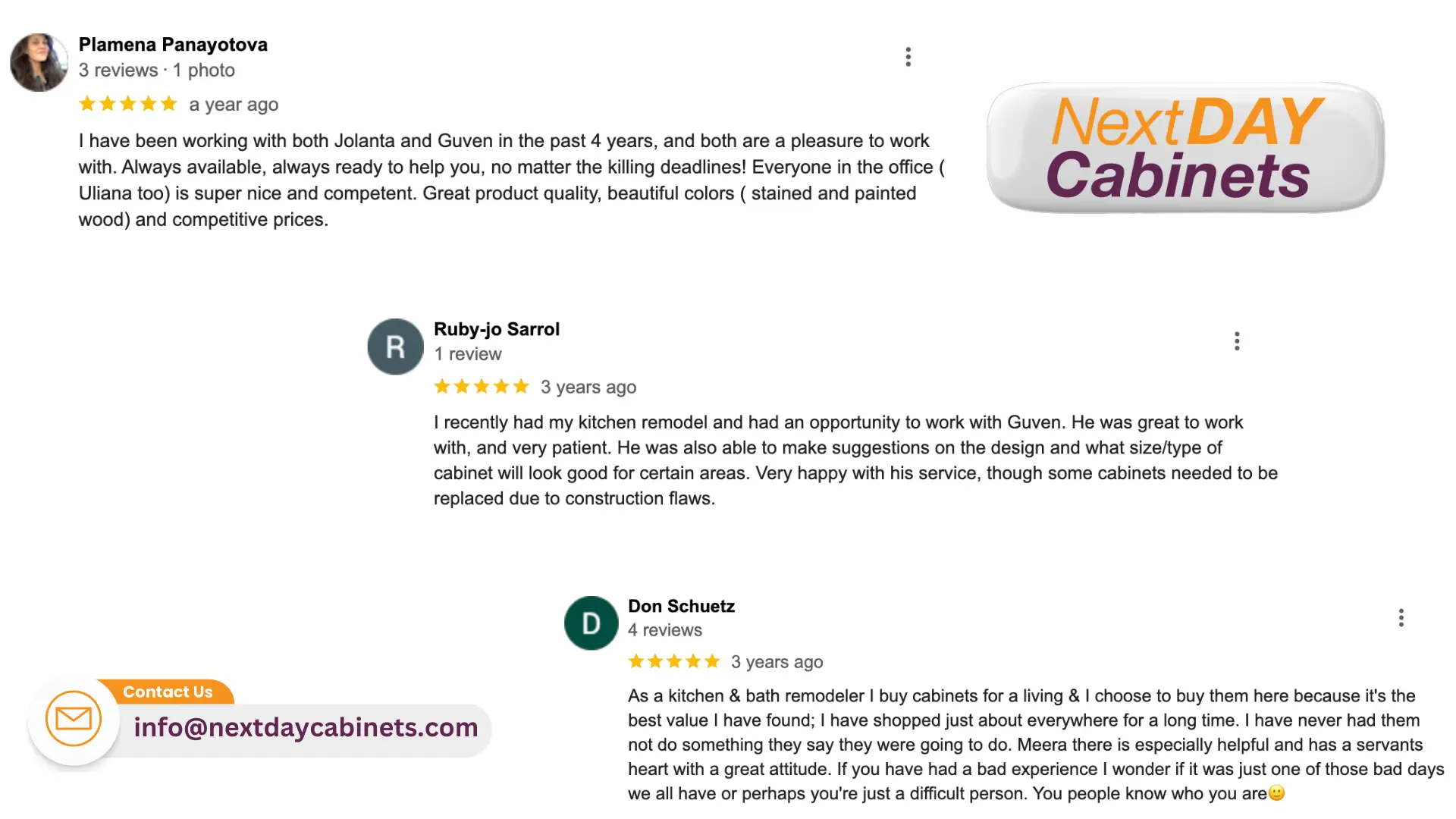
Hear from Our Delighted Kitchen Cabinets Buying
Plamena Panayotova, Long-Term Client
Plamena Panayotova, a loyal customer for over four years, commends NextDay Cabinets for their exceptional service and team. She particularly praises Jolanta and Guven for their constant availability and readiness to help, even under tight deadlines. Plamena also highlights the entire office staff, including Uliana, for their competence and friendliness. She emphasizes excellent product quality, beautiful color options in stained and painted wood, and competitive pricing.
Ruby-jo Sarrol, Kitchen Remodel Client
Ruby-jo Sarrol shares her positive experience working with Guven during her recent kitchen remodel. She appreciates Guven’s patience and ability to offer valuable design and cabinet selection suggestions. While very satisfied with the service, Ruby-jo notes that some cabinets needed replacement due to construction flaws, demonstrating the company’s commitment to quality and customer satisfaction.
Don Schuetz, Professional Kitchen & Bath Remodeler
As an experienced kitchen and bath remodeler, Don Schuetz chooses NextDay Cabinets for their unbeatable value. He praises the company’s reliability in delivering on their promises and singles out Meera for her helpful nature and great attitude. Don’s professional endorsement underscores the company’s standing in the industry and their consistency in meeting the needs of trade professionals.
Choose NextDay Cabinets for your wholesale cabinet needs and experience the same level of satisfaction as Plamena Panayotova, Ruby-jo Sarrol, and Don Schuetz. Our dedicated team excels in providing high-quality cabinets, offering expert design assistance, and ensuring customer satisfaction across various projects.
From long-term professional relationships to first-time remodelers, we pride ourselves on our attentive service, design expertise, and commitment to meeting deadlines. Our team, including standout members like Jolanta, Guven, Uliana, and Meera, is known for their competence, patience, and willingness to go the extra mile for our customers.
At NextDay Cabinets, you’ll find a wide range of beautiful cabinet options with competitive pricing, making us the go-to choice for homeowners, industry professionals, and contractors. Our quality focus, knowledgeable staff, and customer-first approach ensure that your cabinet selection and installation process will be smooth and satisfying.
Whether you’re a seasoned remodeler looking for the best value, planning a kitchen renovation, or a trade professional seeking a reliable partner, NextDay Cabinets is committed to exceeding your expectations with our product quality, design services, and outstanding customer support. We stand behind our products and are dedicated to resolving any issues that may arise, ensuring your complete satisfaction.
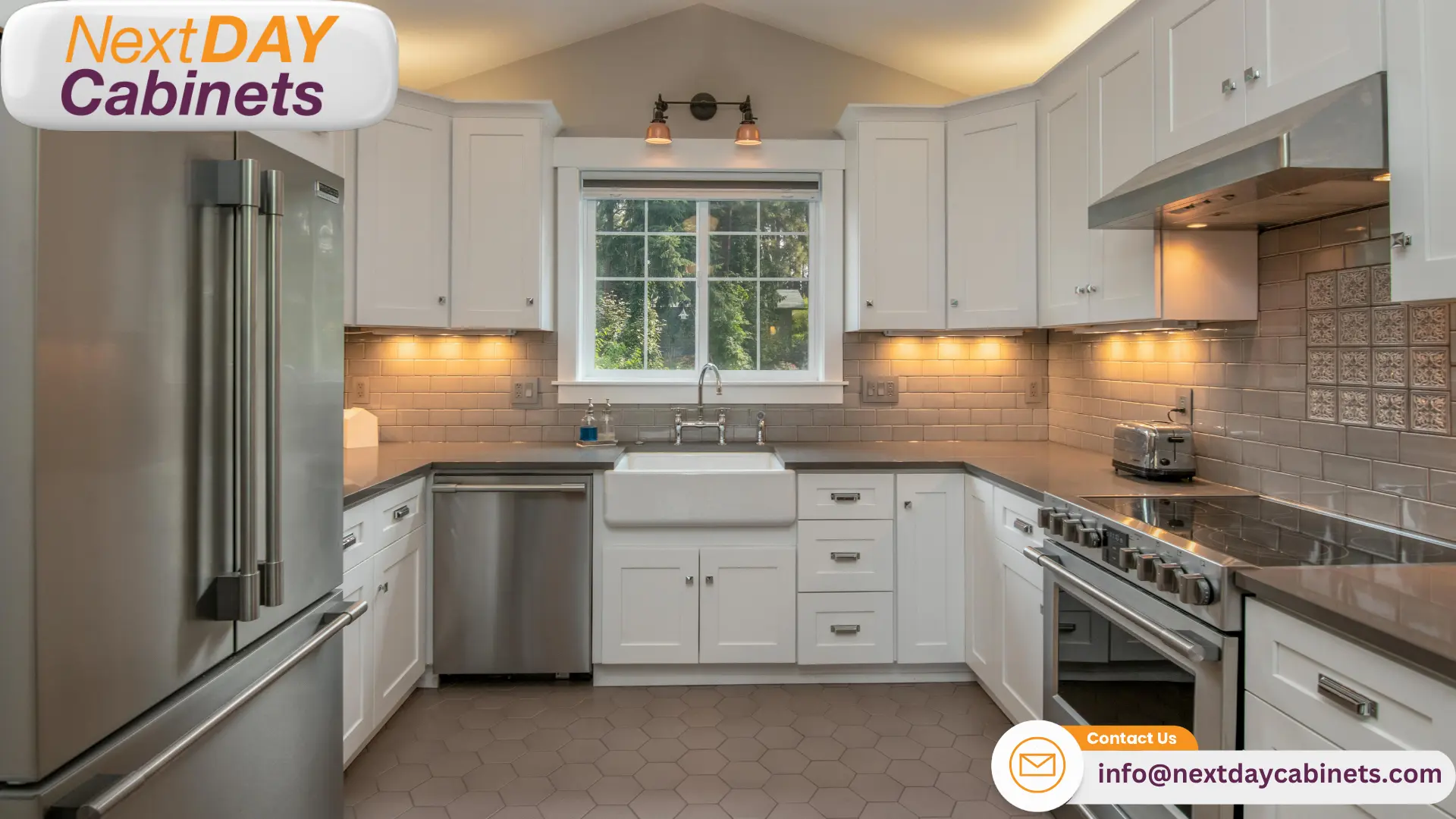
Transform Your Home with NextDAY Cabinets
NextDay Cabinets offers a wide range of high-quality kitchen cabinets and bathroom vanities at affordable prices. As the Mid-Atlantic’s best cabinet wholesaler, we serve six locations: Chantilly, Alexandria, Woodbridge, Richmond, Beltsville, and Chicago.
Visit Our Showrooms
- Chantilly Showroom: 14000 Thunderbolt Pl Suite K, Chantilly, VA 20151
- Alexandria Showroom: 5655 General Washington Dr., Suite E, Alexandria, VA 22312
- Woodbridge Showroom: 3099 PS Business Center Dr, Woodbridge, VA 22192
- Richmond Showroom: 3985 Deep Rock Rd, Richmond, VA 23233
- Beltsville Showroom: 5801 Ammendale Rd, Beltsville, MD 20705
- Chicago Showroom: 1801 Estes Ave, Elk Grove Village, IL 60007
Why Choose NextDAY Cabinets?
- Guaranteed Lowest Price: We ensure customer happiness and loyalty by providing top-quality construction at low factory-direct prices.
- Fast Lead Times: We offer some of the fastest lead times in the industry, with many orders ready in just 3-5 days.
- Professional Design Services: Our experienced design consultants help you create the perfect kitchen for your needs.
- High-Quality Products: All our cabinets are made from 100% solid wood and are KCMA certified, ensuring durability and environmental safety.
NextDAY Cabinets offers the best American made cabinet brands like:
Crestwood, Decora, Forevermark Cabinetry, Mantra, Marsh, Nations Cabinetry, Waypoint, WellKraft Cabinetry, Wolf Home Product in Mid-Atlantic area with 6 showrooms in Chantilly, Alexandria, Woodbridge, Richmond, Beltsville, and Chicago. Check out the exciting cabinets with a wide range of kitchen cabinets buying options at NextDAY Cabinets now!
Contractors, Dealers, and Builders! Are You Ready to Transform Homes? Become a dealer now!
Visit our Gallery now! Contact us and start your journey toward modern homes today.
Conclusion
This guide offers contractors essential insights for selecting and purchasing kitchen cabinets. By understanding client needs, exploring material options, and considering design elements, contractors can make informed decisions that balance quality and cost-effectiveness.
Establishing relationships with reliable suppliers and implementing efficient installation practices are crucial for project success. These strategies help contractors streamline their processes and deliver superior results to clients.
Effective cost management and competitive pricing strategies enable contractors to maximize profits while meeting client expectations. By leveraging bulk discounts and optimizing project budgets, contractors can offer attractive pricing without compromising quality.
Ultimately, this guide equips contractors with the knowledge and tools to successfully navigate the kitchen cabinet market. By applying these insights, contractors can enhance their services, satisfy clients, and grow their businesses in the competitive renovation industry.
